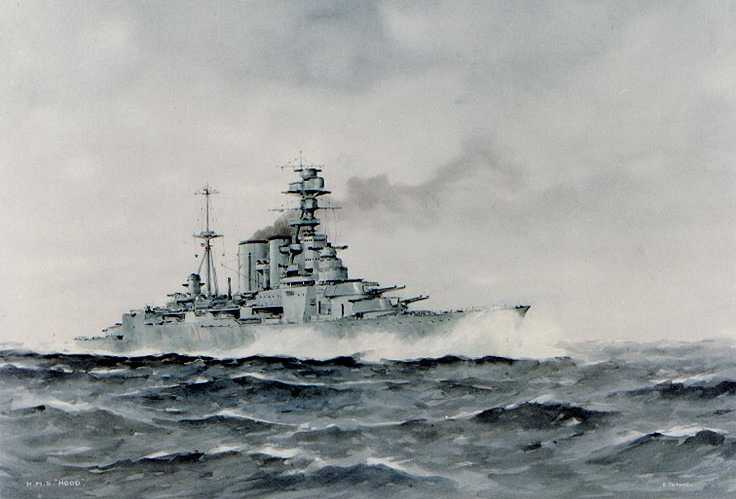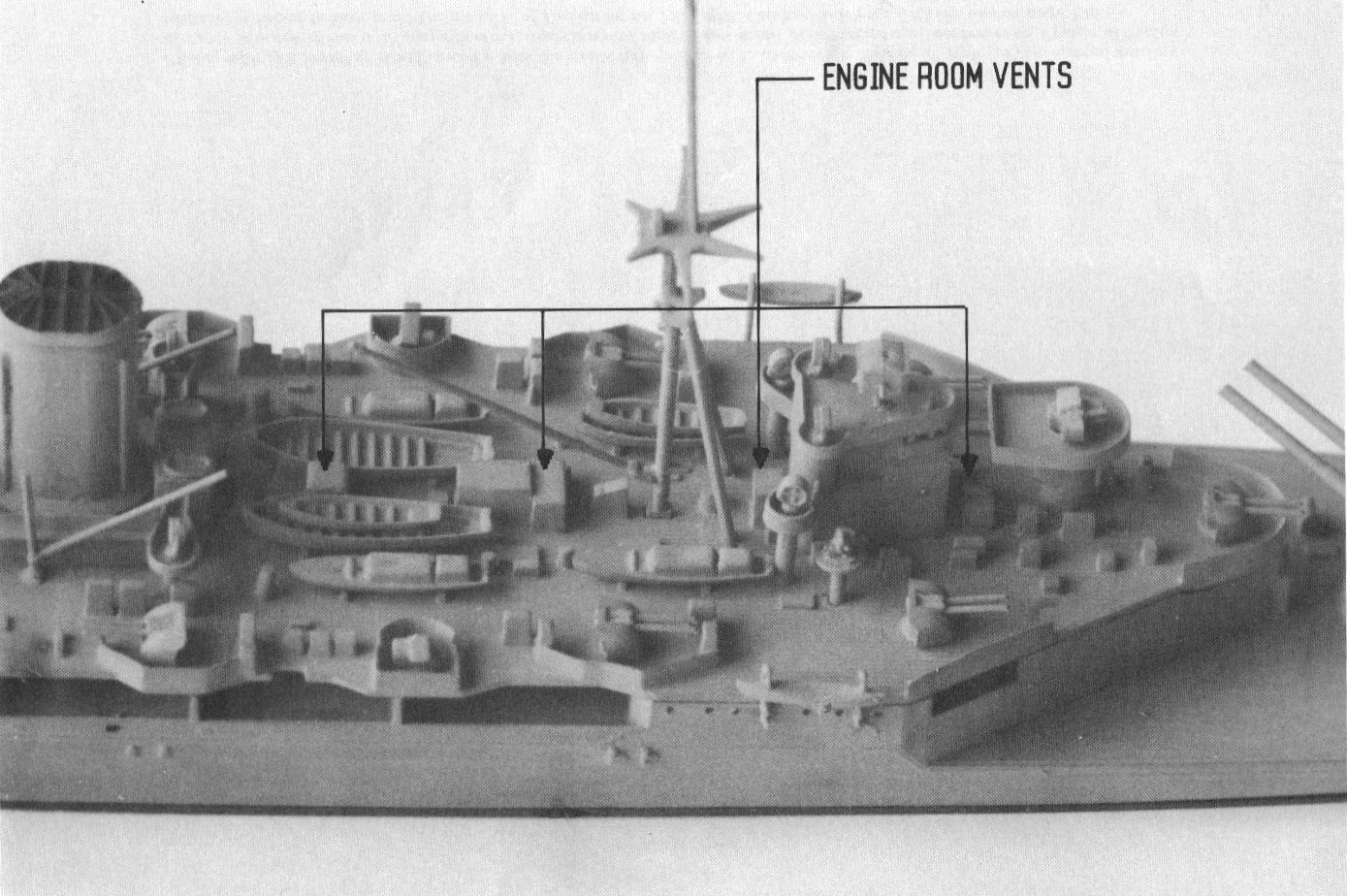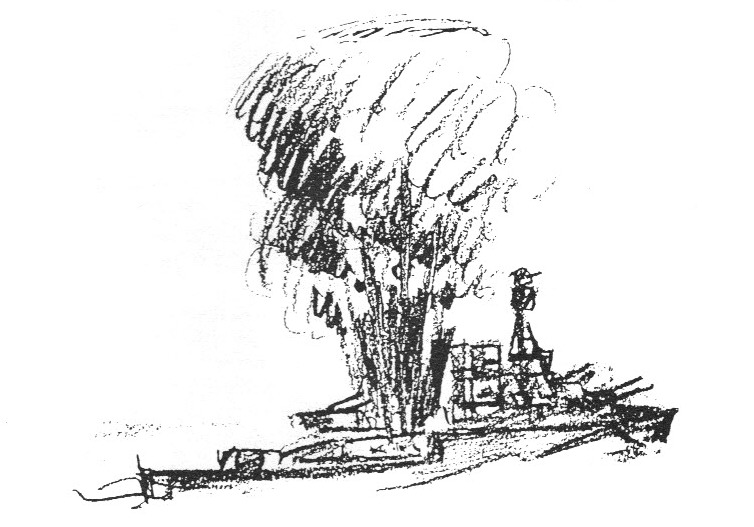
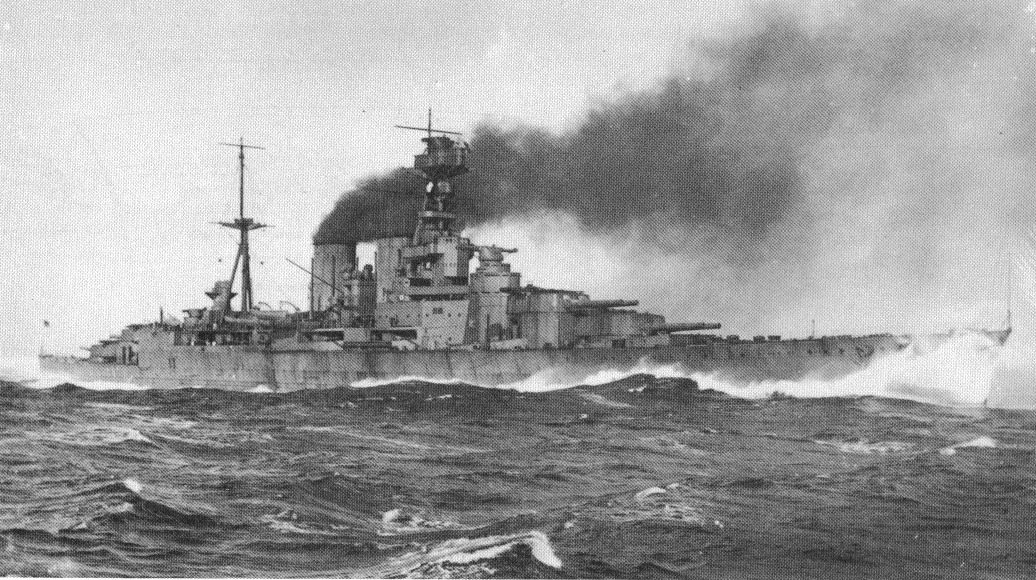
More than half a century ago, the British battlecruiser HMS Hood and the German battleship Bismarck fought what was arguably one of the most famous surface engagements of the Second World War. In an instant on the morning of the 24th of May, 1941, the Royal Navy lost the symbolic flagship of its fleet and the battleship Bismarck, which would have otherwise had an interesting but unremarkable history, was transformed into one of the most well-known ships of the war. In much the same way that the loss of the Hindenburg brought a spectacular end to the era of the airship as a credible flying machine, the loss of the Hood marked the end of the battlecruiser as a credible fighting machine.
Since then, the story of Hood's loss and the subsequent hunt for the Bismarck has spawned at least one popular song, a major motion picture, more than a dozen books, and innumerable accounts in the popular literature. In spite of this, however, no complete post-war technical analysis of the loss of Hood has ever reached print. It is the purpose of this paper to attempt to redress this omission.
Anyone approaching this event from a distance of sixty years is possessed of both advantages and disadvantages compared to those who have gone before. Unlike the original investigators, postwar research can provide him with comprehensive and accurate information on the ballistics and armor penetration capabilities of German guns of the period. Unlike the original investigators, he can take advantage of the observations of witnesses from both sides of the battle. Free of the pressure of events and internal politics, he has the luxury of attempting a more exhaustive and objective survey than the members of the original boards could hope to provide.
Of course there are disadvantages to this situation as well. To begin with, he is more than fifty years distant from the events of the 24th of May 1941. He cannot call new witnesses, or, with remarkable exceptions, recall old ones. Perhaps, most significantly, he has no "walking on" experience with the ship herself. To the members of the original boards of inquiry, Hood was not a collection of old photographs, musty engineering drawings and abstruse equations, but a concrete entity, as familiar to them as our homes and workplaces are to us.
For a variety of reasons, the exact mechanism of the loss of Hood will probably never be known with certainty. The event occurred with remarkable suddenness, and was to most observers completely unexpected. No cameras were clearly trained on Hood as she exploded and no "black box" counted down her final, fatal, seconds. There were almost no survivors and there remained virtually no wreckage on which post-mortem might be performed. The results of past investigations - and this one - must be judged with that in mind. Those charged with inquiring into more modern disasters are by comparison usually virtually awash in a sea of data.
The design of HMS Hood dated back to the middle of World War I. Although the Royal Navy was secure in the knowledge that its superiority in battleships was unassailable, the Admiralty remained concerned about possible German superiority in battlecruisers, which if tactically well employed could exert an influence all out of proportion to their numbers. Thus it was that Hood and her three proposed sisters were specifically designed to counter the three fifteen-inch gunned battlecruisers which Germany laid down in 1915 and the four more which she laid down the following year. Ironically, Hood began her life as a fortunate survivor. Once Germany became aware of the British intent to match her battlecruiser buildup, she abandoned battlecruiser construction to concentrate on the production of submarines and the Admiralty correspondingly cancelled its ships as well, leaving Hood the sole survivor of an unlucky group that would once have totaled eleven. At 41,200 tons and 860 ft 7 in [262.31 meters] overall length, Hood was for many years the largest and most prestigious warship in the world.
The original design for Hood was approved on 7 April, 1916 and the ship laid down on 31 May. On that very day, in what was to become the penultimate naval engagement of the First World War, three British battlecruisers, the Indefatigable, Queen Mary and Invincible blew up under German fire at the Battle of Jutland. "Something seems to be wrong with our bloody ships today . . .", commented a shaken British admiral, and in fact a thorough investigation into the apparent fiasco was ordered immediately after the battle was over. The investigators (probably incorrectly) concluded that the loss of the three battlecruisers was the result of propellant fires reaching the magazines rather than penetrations of deck or belt armor and thus changes to new designs and existing construction centered around improved anti-flash protection rather than the provision of additional armor. Nonetheless, perceived deficiencies in the design of Hood were considered serious enough to justify suspending work to allow a rather substantial redesign, including a reworked armor scheme and work was not resumed until 1 September. Table I below shows the changes made between the original and final designs.
| Original Design of 7 April 1915 | Final Design of 30 Aug. 1917 | |
|---|---|---|
| Displacement | 36,300 tons | 41,200 tons |
| Length overall | 860.0'-0" (262.13m) | 860.0'-0" (262.13m) |
| Beam | 104'-0" (31.70m) | 104'-0" (31.70m) |
| Mean Draft | 25'-6" (7.77m) | 28'-6" (8.69m) |
| Speed | 32 knots | 31 knots |
| Upper belt | 3" (76mm) | 5" (127mm) |
| Middle belt | 5" (127mm) | 7" (178mm) |
| Lower belt | 8" (203mm) | 12" (305mm) |
| Forecastle deck | 1.25" (32mm) | 1.625" (41mm) |
| Upper deck (average) | 1" (25mm) | 1.25" (32mm) |
| Main deck (average) | 1.5" (38mm) | 1.875" (48mm) |
| Lower deck (average) | 1.625" (41mm) | 1.6" (41mm) |
| Average belt | 5.3" (135mm) | 8" (203mm) |
| Total Decks | 5.375" (137mm) | 6.35" (161mm) |
| Armor Weight | 10,100 toms | 13,550 tons |
| % Disp. devoted to armor | 27.8% | 32.8% |
| Inner limit Immune Zone1 | 31,000 yards | 22,500 yards |
| Outer limit Immune Zone | 26,200 yards | 29,500 yards |
| Width of Immune Zone | -4,800 yards | +7,000 yards |
The addition of extra armor in the final design represented a significant improvement; without it, the immunity zone1 against German 380mm shells would actually have been negative. Despite the addition of some 3,450 tons of additional armor and protective plating, however, Hood was still considered vulnerable to long range fire. Although several schemes were put forward to update her over the years, none were ever carried out. Although as late as 1940, Jane's Fighting Ships was stating that ". . .the general scheme of protection is most comprehensive," in Admiralty circles her actual protection was always considered marginal. In 1920, trials with built up targets representing Hood were conducted and showed that her magazines could be reached by a 15-in shell penetrating the 7-in [178mm] belt. In a number of almost incredibly prophetic diagrams, the Admiralty sketched the path of the shells and showed how the addition of 3-in [76mm] of additional deck armor could have prevented potential disaster.2 Three of these sketches are reproduced below.
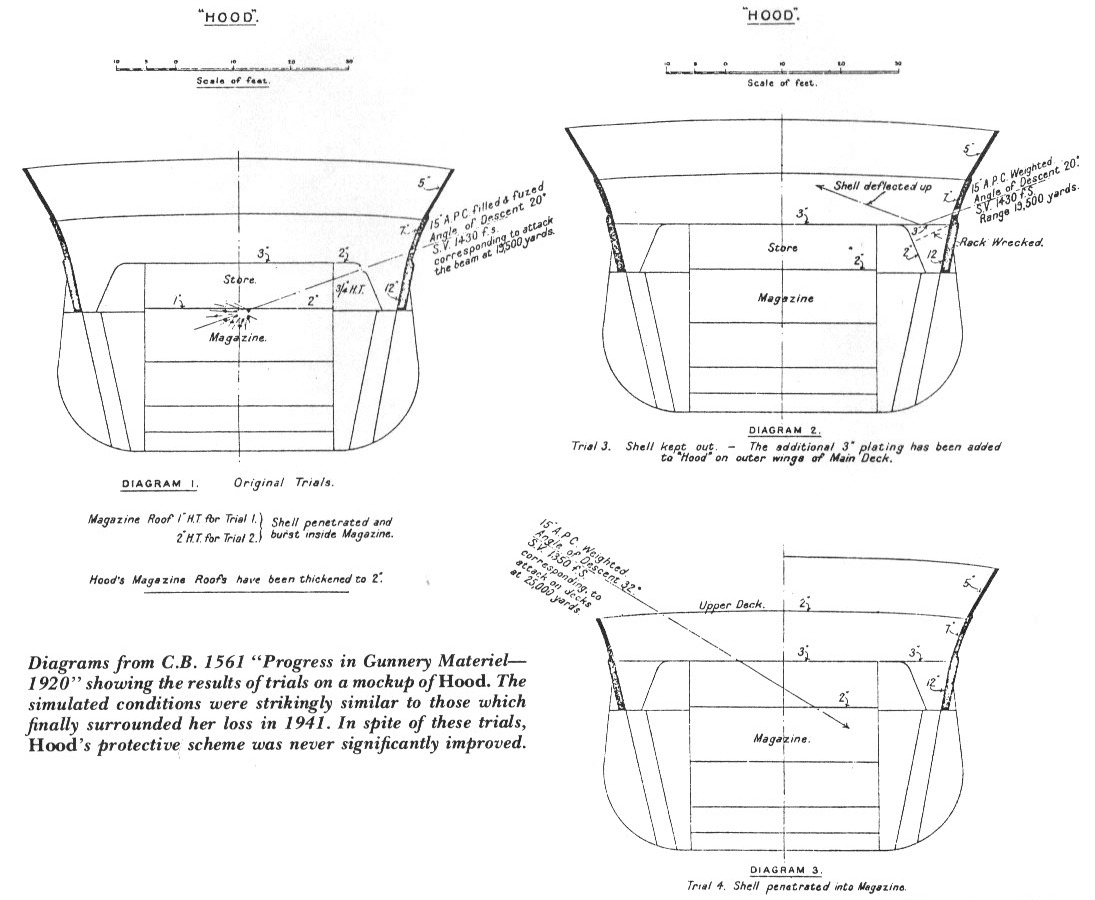
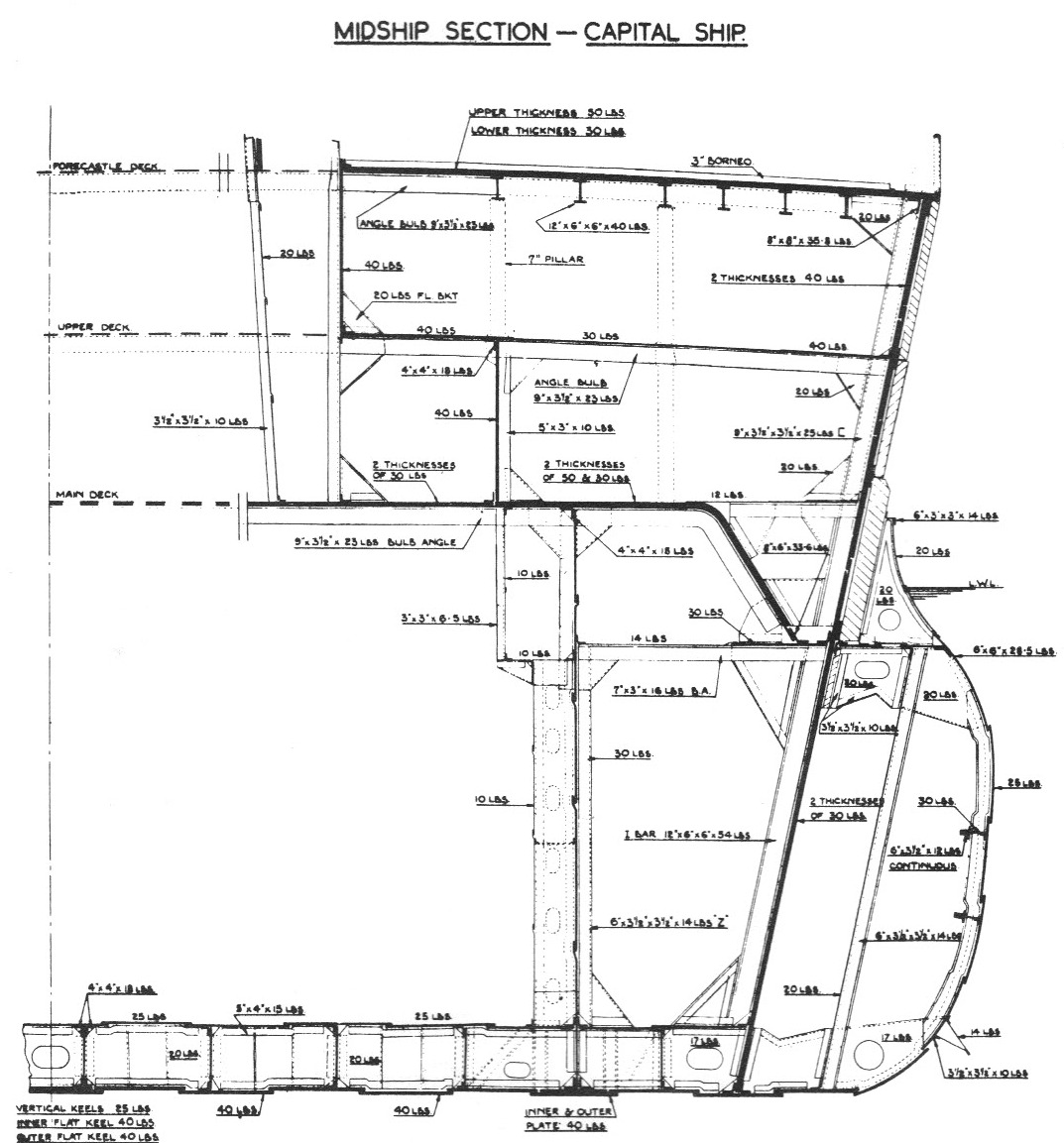
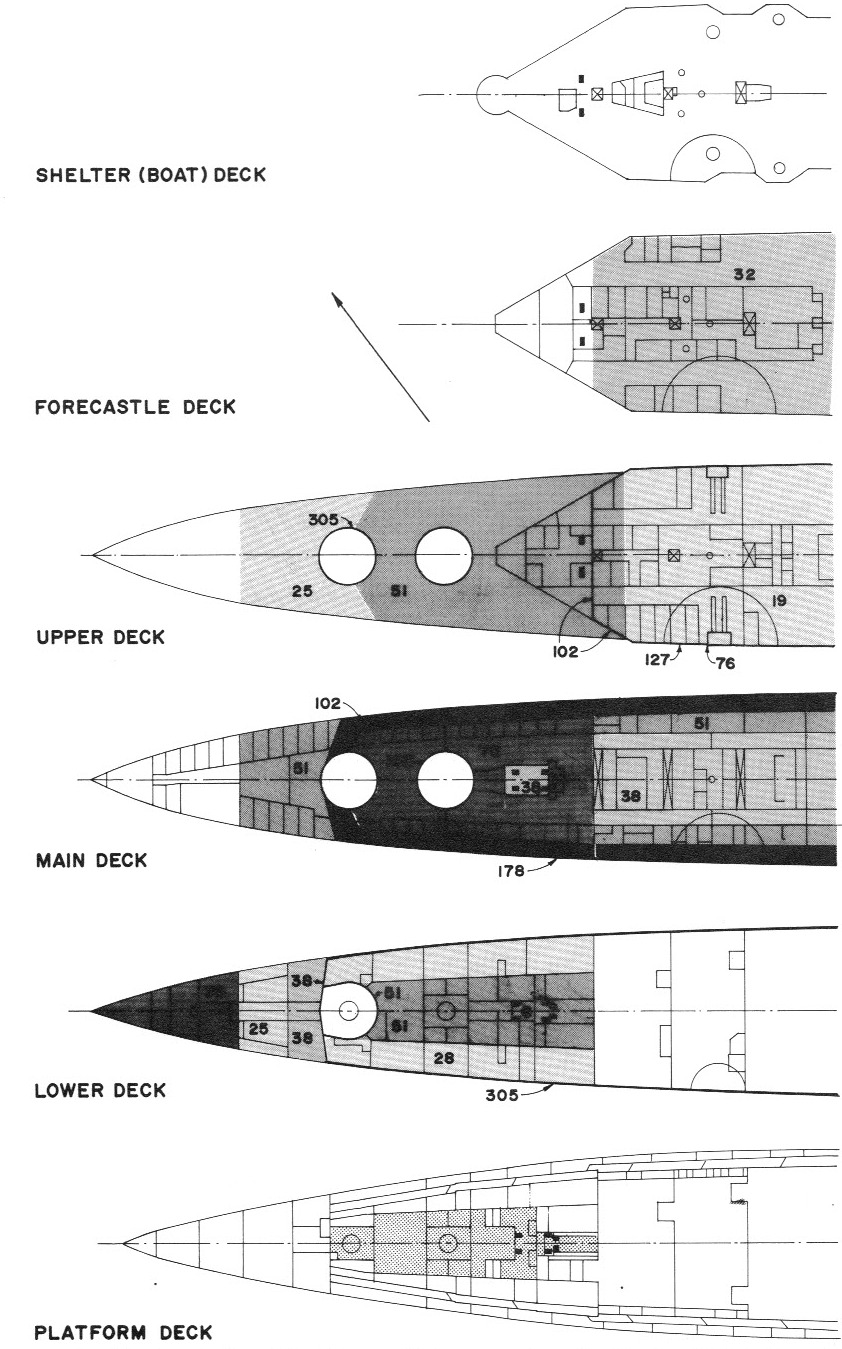
Hood's final voyage began at 0050 on Thursday, 22 May, 1941,3 as she passed Hoxa gate of Scapa Flow in company with battleship Prince of Wales and six destroyers. Shortly thereafter, word was received that the group would proceed to Hvals Fjord in Iceland to prevent Bismarck from attacking convoys. As the situation developed, the group remained at sea instead, less destroyers Anthony and Antelope, which were detached at 1400 23 May.
Hood's crew gained their first clue that something was developing at 1939, 23 May when full speed was ordered. At 2002, a message from cruiser HMS Suffolk reported the enemy as one battleship and one cruiser, course 240 degrees, in a position that translated to some 560 kilometers distant and almost directly north of the battlecruiser force. Thirty-eight minutes later a contact report was also received from the cruiser HMS Norfolk. Speed was increased to 26 knots at 2045 and 27 knots at 2054. Eleven minutes later, B.C. 14 signaled to destroyers; "If you are unable to maintain this speed I will have to go on without you. You should follow at your best speed." Not to be outdone by their larger counterparts, the destroyers kept up.
Prince of Wales' narrative for Saturday the 24th, and Hood's final dawn, continues:
"Weather at 0001: Wind North, force 4-5, visibility - moderate, Sea and swells 3-4. At this time report put the enemy 120 miles [c. 224 km] 010 degs., from battlecruiser force, approx. true course 200 degs. Speed was reduced to 25 knots at 0008 and, course altered by blue pendant5 to 340 degs. at 0012 and 000 degs. at 0017. At 0015 ships assumed first degree of readiness, final preparations for action were made, and battle ensign hoisted. It was expected that contact with the enemy would be made at any time after 0140. Cruisers at this time had lost touch with the enemy in low visibility and snow storms."
At 0031 B.C. 1 signaled "If enemy is not in sight by 0210 I will probably alter course 180 degs. until cruisers regain touch," followed at 0032 with his plan of the action; "intend both ships to engage 'Bismarck' and to leave 'Prince Eugen' (sic) to 'Norfolk' and 'Suffolk' "6
The British went to action stations at 0015. Visibility deteriorated rapidly beginning about a half-hour later. At 0203 Hood and Prince of Wales turned to 200 degrees and, probably in an attempt to somewhat widen the area of search, detached their four escorting destroyers. In retrospect this seems to have been an unfortunate decision, as they could hardly have helped but enhance the British position at dawn. Feeling by now that the chance of an encounter before daylight was minimal, Holland gave permission for personnel to sleep at action stations, but so tense was the atmosphere aboard the British ships that apparently few crewmen did. Speed was increased to 26 knots at 0214 and 27 knots at 0222, with visibility now slightly over 9,000 meters. At 0256 Suffolk regained contact with Bismarck placing the enemy about 28,000 meters to the northwest of the battlecruiser force. Course was altered to 220 degrees at 0321 and to 240 degrees at 0342. At 0353 speed was increased to 28 knots. Bismarck was considered to be 37,000 meters to the northwest at 0400. Visibility continued to improve, and by 0430 was about 22,000 meters.
Hood and Prince of Wales resumed first degree of readiness at 0510. There was a long wait while the horizon became gradually more distinct and at last at 0535 Bismarck and Prinz Eugen were sighted bearing 335 degrees on an approximate course of 240 degrees, range approximately 38,000 meters. Hood and her consort altered course 40 degrees towards at 0537 and 20 degrees towards at 0549, putting the British on a course of 300 degrees. Prince of Wales took station 4 cables7 distant, bearing 135 degrees from the flagship, i.e., on Hood's starboard quarter. The photograph below shows the relationship between the two ships.
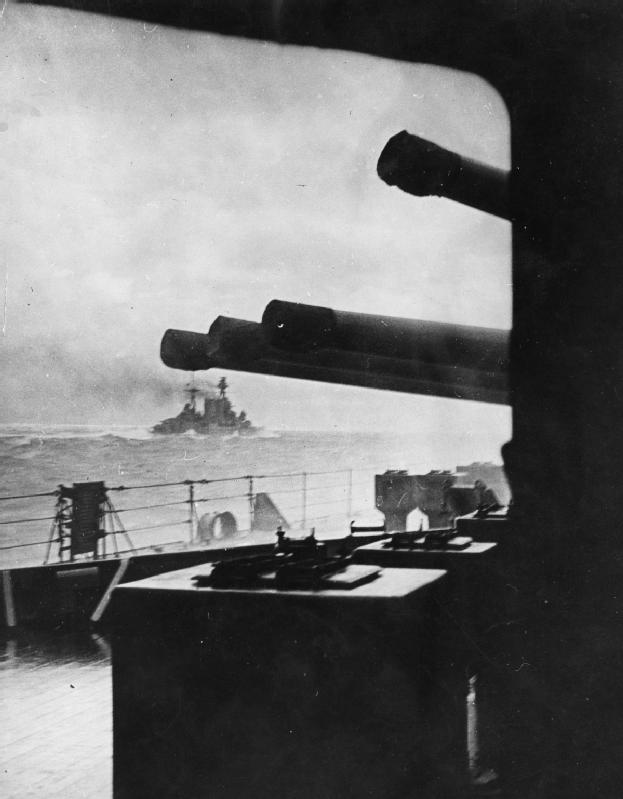
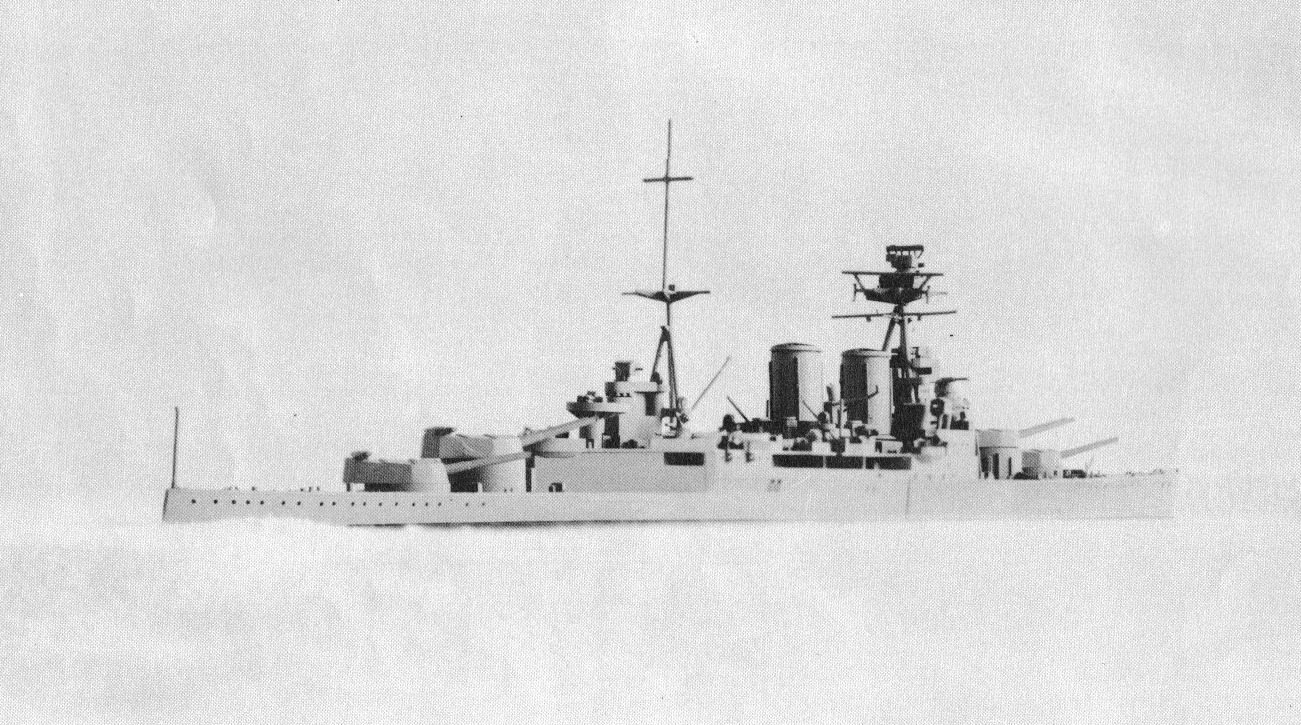
In what was apparently a misguided attempt to close the range rapidly, or perhaps an attempt to follow poorly conceived battle instructions, Hood and Prince of Wales gave away whatever tactical advantage they had at initial contact by holding to their original course for far too long a time, and thereby allowing the Germans to pass ahead.8 Having thus snookered themselves at the outset, the British ships were forced into following a long pursuit curve while tracking the Germans, instead of maneuvering to cut them off. As a perfect pursuit curve would require Hood and Prince of Wales to follow a continuously curving course, and would always keep both German ships directly over the bow, in order to make maneuvering easier and to increase their effective firepower, Holland therefore apparently ordered the curve to be made in a series of straight segments, so arranged as to keep the arcs of their after turrets open. It was, to say the least, far from an ideal solution.9 Even though the British were changing course frequently, which should have greatly hampered German fire control, their rate of bearing drift was small and the Germans' major problem would have been compensating for changes in range.
Prince of Wales' verbatim narrative of the ensuing action reads as follows:10
"During the approach 'Hood' made 'G.I.C.' - followed by - 'G.O.B.I.' - just before opening fire at 0552. Range approx 25,000 yards. 'Prince of Wales' opened fire at 0553. 'Bismarck' replied with extreme accuracy on 'Hood.' 2nd or 3rd salvo straddled and fire broke out in 'Hood' in the vicinity of the port after 4-in gun mounting. Lighter ship engaged 'Prince of Wales.' 'Prince of Wales' opening salvo was observed over, 6th was seen to straddle. At this time 'Prince of Wales' had five 14-in guns in action. 'Y' turret would not bear. Fire in 'Hood' spread rapidly to the mainmast. A turn of 2 blue [indicating a course change of 20º to port] at 0555 opened 'A' arcs at 'Prince of Wales' ninth salvo.11 'Hood' had a further 2 blue flying when, at 0600, just after 'Bismarck's fifth salvo, a huge explosion occurred12 between 'Hood's' after funnel and mainmast and she sank in three or four minutes. 'Hood' had fired five or six salvos, but fall of shot was not seen, possibly because this coincided with firing of 'Prince of Wales' guns."
Fourteen hundred fifteen officers and men of H.M.S. Hood were killed in the explosion, or died in the water shortly thereafter.
Hundreds of eyes watched as Hood approached her end. German eyes watched her through telescopes and periscopes aboard the Bismarck and Prinz Eugen. British eyes watched from the cruisers many miles away. Prince of Wales' helmsman and commanders were watching her to ensure that proper position was maintained. And because she was flag, the signalmen aboard Prince of Wales were watching her intently. Most importantly, the entire population of the port side of Prince of Wales, on the disengaged side and no doubt feeling a little cheated at missing the "real action," had little else to do but watch the giant battlecruiser perform. Here, reproduced as much as possible in the words of the witnesses themselves, is what they saw.
Bismarck fired four-gun salvos throughout. Her first salvo undoubtedly fell forward and slightly to starboard of the Hood. On Hood's bridge, Midshipman Dundas saw it come down close off the starboard bow. Petty Officer Blockley in the port foremost H.A. Director of Prince of Wales watched it fall ". . . ahead of the Hood" and ". . . absolutely correct for range," whilst aboard Bismarck, Burkhard Von Müllinheim-Rechberg in her after gunnery control station heard Korvettenkapitän Adalbert Schneider, controlling Bismarck's salvos call it "short." Observers aboard Prince of Wales watched as Hood steamed majestically through the resultant splashes. Schneider ordered a 400 meter bracket, recording the long salvo as an "over" and judging the short salvo to be a straddle. Sub-Lieutenant John Wormersley, control officer of Prince of Wales' port forward H.A. director saw the long salvo fall ". . . on the port quarter of 'Hood' and over by 200 yards."13 "After this," he said, "a fire appeared on the 'Hood's' boat deck."
Curiously, the fire had nothing to do with Bismarck's gunnery - instead it had almost certainly been caused by a hit from Prinz Eugen who was also firing at the leading British target. Like many other British observers, Wormersley had accidentally confused the fall of shot from Bismarck and Prinz Eugen. From the German cruiser's bridge, her captain watched through binoculars with Commander Busch, a German journalist, as Prinz Eugen's second salvo struck home, and listened as Commander Jasper, the gunnery officer confirmed it. Within two minutes of opening fire, Prinz Eugen's gunners had drawn blood.
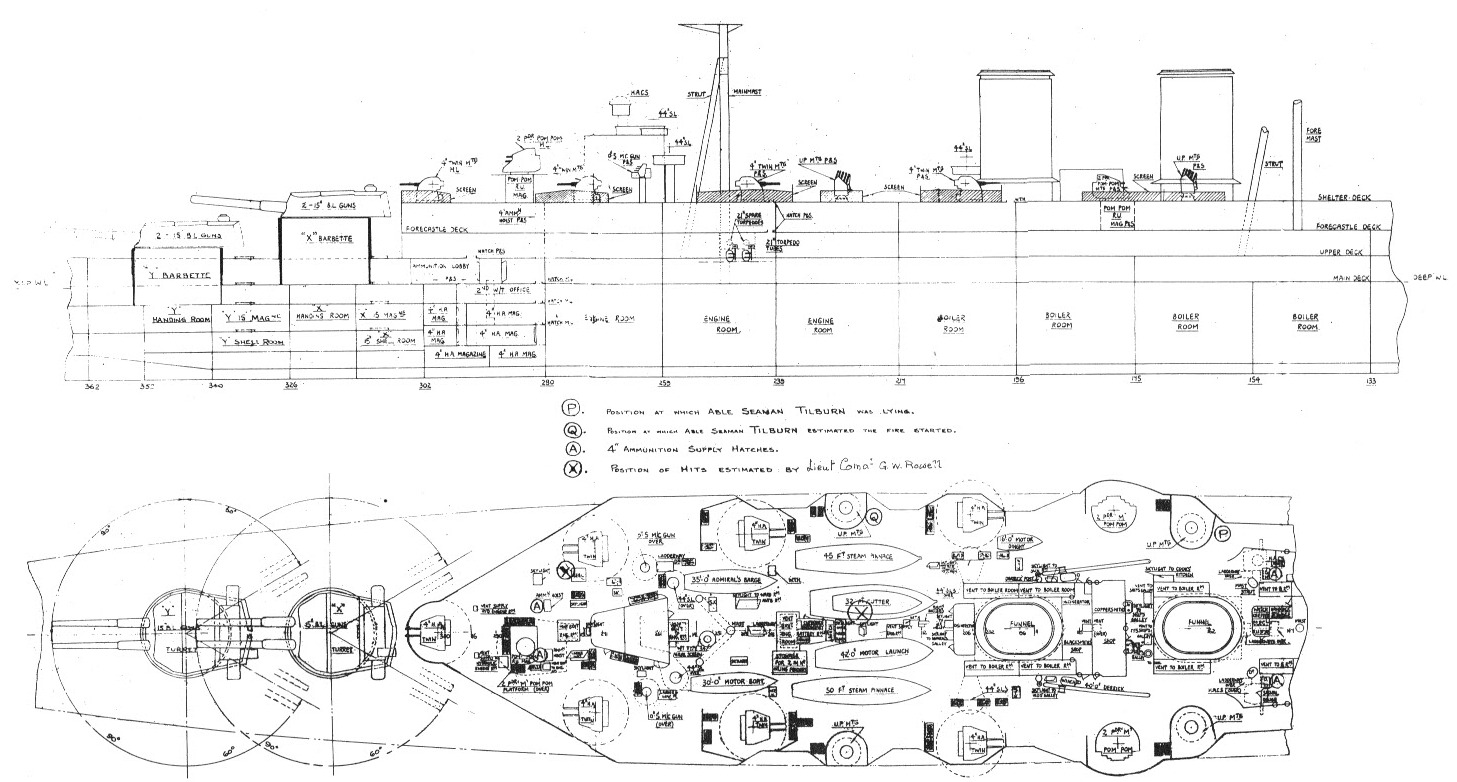
Observer's impressions of the hit that caused the fire are mixed. From the port side of Prince of Wales Admiral's shelter deck P.O. Lawrence Sutton observed ". . . a salvo of H.E. fall more or less in line amidships of the 'Hood' also short. This was of smaller caliber than the other two."14 The second salvo from Bismarck ". . . appeared to go over," he said, "and at the same time there was a flash just before the mainmast of the 'Hood' and there was a volume of black smoke which afterwards turned into grey . . ."15 Lt. Cdr. Rowell, navigating officer of Prince of Wales, saw three splashes and saw the fourth shell hit. Later, he marked the position of the hit clearly on the ship's plans - close to the P.3 Twin 4-in Mounting about 275 station.16 Chief Petty Officer William Mockridge, who had done equipment trials of the 4-in guns and supply arrangements in 1940, saw the fire break out and was sure it was based in the 4-in ready use lockers, many of which were distributed in the vicinity. "I saw a very vivid flash," he said. "It was so bright, like a magnesium flare." Although Mockridge shifted his periscope forward and thus missed the actual explosion itself, the flame burned for at least ten seconds, he said, and ". . . was still burning when I shifted my periscope."
The fire on the boat deck continued to burn from the time of the hit until Hood was destroyed. Its effects evidently did not penetrate deep into the ship, as Hood's engine rooms were apparently unaffected, and her speed remained unaltered to the end. It was, nonetheless, a substantial blaze. Sergeant Terence Charles Brooks of the Royal Marines observed the scene through his periscope in P1 turret of Prince of Wales: "The second salvo from 'Bismarck' arrived and landed two on the starboard side and one inboard on the 4-in gun deck. The remainder I did not see. Immediately afterwards there was an enormous flash of flame on the 4-in gun deck starboard side aft. Just before this I had seen the 4-in guns crews clustered round the guardrail on the starboard side of the 4-in gun deck of the 'Hood.' After the shell landed all that I could see was a mass of flame as high as the mainmast. I could see nothing then of the 4-in gun crews . . ."17 Boy Leonard Burchell on the P.1 Pom Pom deck, however, could see men on the boat deck - each of whom was living the last few minutes of his life - trying to put out the fire with hoses.18 Lt. Cdr. Cecil Lawson, who watched through the periscope in Prince of Wales' "A" turret emergency conning position was ". . . much impressed, . . . that dense volumes of smoke were pouring out of the superstructure, the entire length of the boat deck."19
Leading seaman Hubert Fackrell, in communication with Hood by box light, saw it as ". . . a fire with bright flame - it was a blue flame - and I got the impression at the time that it was a cordite fire. The flames were very fierce and very high . . ."20 Petty Officer Cyril Coates got the impression of ". . . a shower of sparks on the boat deck not far abaft the after funnel about amidships, followed by one roll of flame from the after screen which enveloped the after turrets." He watched as ". . . the screen doors were blown off and an oily looking flame came through onto the quarterdeck."21 Able Seaman John Boyle looked through the periscope of P.2 gunhouse as the fire seemed to take up all the superstructure, with flames coming up both sides of it,22 while A.B. Walter Marshall, also on the Pom Pom deck, saw it as ". . . flames coming from what I thought was a fan-shaft on the port side of the boat deck between the mainmast and 'X' turret."23
Aboard Hood, A.B. Robert E. Tilburn was lying down - the safest position for unoccupied personnel during action - on the boat deck on the port side just before Hood's port forward U.P. mounting and just abreast the forward funnel. He saw the projectile hit - just one, he was certain - on the extreme port side just at the forward edge of the aftermost U.P. mounting. "That hit us somewhere . . . ," he heard a shipmate say. The shell was, he testified ". . . a small one, because I don't think the deck was very thick and I think a big one would have gone through."24 "Could you say whether this shell penetrated the deck or not?" inquired the Investigative Board. He could not. He was, however, fairly certain that the resultant fire was of cordite. Although he didn't know whether the petrol for the boats ". . . two or three ten gallon drums and a big drum on a slipway," had been dumped, he thought the fire was too far forward to have been petrol in any case. An order was given to put the fire out, he recalled, but almost immediately countermanded because of the exploding ammunition. The explosions were fairly small, he said, ". . . like Chinese crackers," and didn't seem to cause the fire to spread very much, at least not in his direction. "Was the hatch for the 4-in ammunition hoist abreast the after funnel open or closed?" asked the court. "It was shut," he said, "I had asked the officer for orders and he had told me to leave it shut."
Ordinary Signalman Albert Edward Briggs recalled the events from Hood's compass platform, and was able to give a word-for-word of the conversations that he heard there.25 As the first shell hit, the Squadron Gunnery Officer said "She has hit us on the boat deck and there is a fire in the ready use lockers." 'Leave it until the ammunition has gone,"26 the Admiral replied. After that, he recalled that contact to the spotting top had been lost as well. Although he never actually saw the hit, to Briggs the hit seemed to be on the starboard side, ". . . because we all tended to fall over to starboard." On the upper bridge, Midshipman W.J. Dundas recalled the torpedo officer, who was at the starboard after end of the bridge, report a cordite fire on the starboard side of the boat deck.27
Fifteen miles away, in H.M.S. Norfolk, Rear Admiral Wake-Walker, watched as the fire ". . . spread forward until its length was greater than its height" and then begin to die down. "As it died down," he said, "I saw her two fore turrets fire and the thought 'they may be able to get it under,' came into my mind."28 All around the scene of the action, other observers recalled thinking exactly the same thing.
Just then, Hood exploded.
Aboard Prince of Wales, Captain Leach had been anticipating trouble. He had just watched clinically as a salvo ". . . appeared to cross the ship somewhere about the mainmast. In that salvo were, I think, two shots short and one over, but it may have been the other way round. But I formed the impression at the time that something had arrived on board 'Hood' in a position just before the main-mast and slightly to starboard. . . . I in fact wondered what the result was going to be, and between one and two seconds after I formed that impression an explosion took place in the 'Hood' which appeared to me to come from very much the same position in the ship."29 Commander George William Rowell, also on Prince of Wales' bridge, thought two shells had hit in the fatal salvo instead of one. Although he discussed it at length with Leach, they eventually agreed to disagree.
To most observers the explosion was an awe-inspiring event. It temporarily blinded Sergeant Brooks, watching through his periscope. On board Prince of Wales, Signalman Alan Cutler remembered the yeoman of the watch taking him around to the other side of the flag deck to avoid shrapnel - a needless precaution it transpired, as evidently none arrived aboard.30
To others it was surprisingly unspectacular. To Lt. Peter Slade and A.B. Richard Scott, who were on the catapult deck of Prince of Wales preparing to fly off the aircraft, the explosion revealed itself as a silent red glow reflected from the surrounding bulkheads.31 The impressions of many others were nearly the same. Almost everyone agreed it was essentially noiseless, or at least sufficiently quiet that it was drowned out by the sound of Prince of Wales' own guns and machinery. Esmond Knight, in the air defense station above Prince of Wales' bridge, and who was to lose his sight in the next few minutes of action, was later to recall ". . . I remember listening for it and thinking it would be a most tremendous explosion, but I don't remember hearing an explosion at all."32 David Wilson Boyd of Prince of Wales recalled that "She went up with more of a rumble than a bang." Others described the explosion as ". . . a deep, dull, roar," "a noise like squashing a match box on a bigger scale," or as similar to the sound one might make by hitting a vent duct with a fist. Band Master 2nd Class Percy Cooper in Prince of Wales' Port Forward H.A.C.P. below the waterline clearly recalled hearing Hood's gunfire before the explosion, but strangely never heard the explosion itself, or felt any shock.33 Horace Jarret, a commissioned engineer who had experienced depth charges only a few days before, was in Prince of Wales' 'B' boiler room and also felt nothing significant. "Even now, looking back, I can think of no effect," he would later tell the court.31
To Able Seaman Tilburn, still lying down on Hood's boat deck, the explosion was almost unbelievably innocuous. "Did you feel any particular blast yourself?" the court questioned. "No, Sir," he replied. The noise ". . . was just as if the guns had fired, ". . . there was dead silence after the explosion." As he floated in the water afterward, he noticed ". . . a lot of long steel tubes, sealed at both ends. . . . Roughly 15 ft long and 1 ft diameter" floating about him, evidently crushing tubes from the ship's side protection system. "Could you describe the color of these tubes?" inquired the court. "Rusty," he replied.
On Hood's bridge, Signalman Briggs recalled "There was not a terrific explosion, but the officer of the watch said to the Admiral that the Compass had gone and the Admiral said move over to the after control." Hood initially ". . . listed 6-7° to starboard and shortly after that the Admiral said she listed right over to port." "I was just flung forward on my face," he would testify, with others ". . . falling in all directions." Briggs, Dundas and Tilburn were the only survivors from a crew that totaled fourteen hundred eighteen.
Aboard Prince of Wales, Captain Leach saw the explosion as ". . . a very fierce upward rush of flame the shape of a funnel, rather a thin funnel, and almost instantaneously the ship was enveloped in smoke from one end to the other." To Rowell, the explosion was ". . . very definitely a vertical sheet of flame . . . I might say egg-shaped." Leading Seaman Winston Littlewood, O.N., the trainer of Suffolk's Port H.A. Director saw it as ". . . a huge orange pillar of sparks going in the air and clouds of black smoke. It was a narrow pillar," he recalled, ". . . going up very high . . . When it reached to the top it fell over on both sides." The explosion, he said, ". . . scintillated like stars . . . like a type of firework."34 To Petty Officer Lawrence Sutton ". . . the starting of it was a thin column of flame because it attracted my attention the way it shot into the air abaft the mainmast and before 'X' turret." Then ". . . a huge flash came up all around 'Y' turret," he said, accompanied by ". . . a tremendous roar, mingled with the noise of 'Y' turret firing."
Terence Brooks saw the fatal salvo arrive through the periscope of Prince of Wales' P.1 gun turret. "It seemed to me that one shell went into the ship by the after funnel, and one also seemed to enter the ship by the barbette of 'X' turret. There was an enormous flash which blinded me for a few moments. . . . When I looked through my periscope again I was in time to see a black ball of smoke out of which I distinctly saw a 15-in gun thrown through the air followed by what appeared to be the roof of a turret."35 William Westlake saw spurts of smoke coming out of five or six places just as the explosion began. Petty Officer Frederick Albert French saw the explosion begin as a bulge in the boat deck, between the after funnel and the mainmast. ". . . the boat deck appeared to raise in the middle [and] all what I term cordite fumes came from underneath the ship from aft and about abreast the after funnel," he testified. It looked, ". . . like the crown of a cap being pushed up from below." There followed a tremendous explosion. Hood's stern simply ceased to exist. Her bow reared up - ". . . like the spire of a giant cathedral," a German observer would note - and within three minutes she was gone.

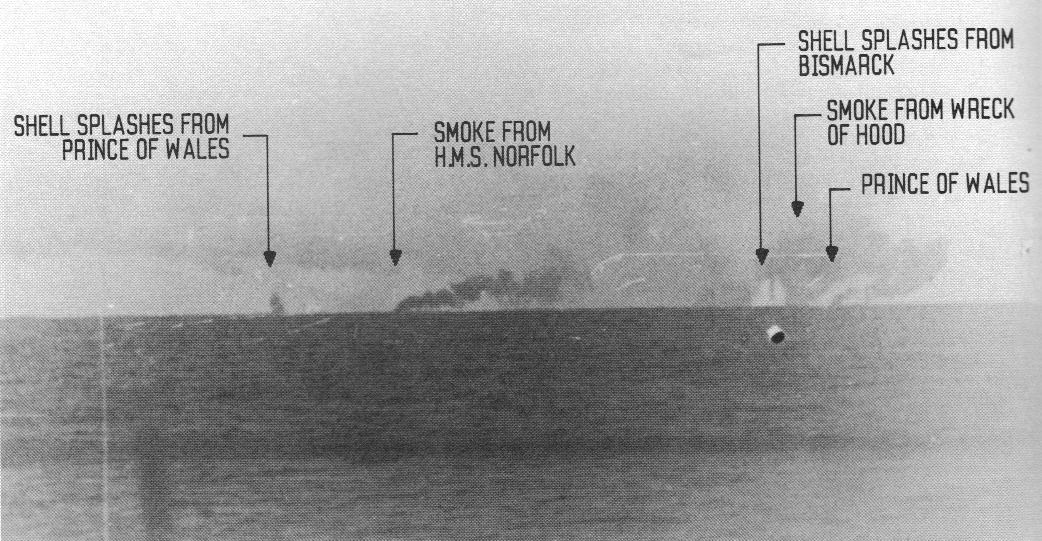
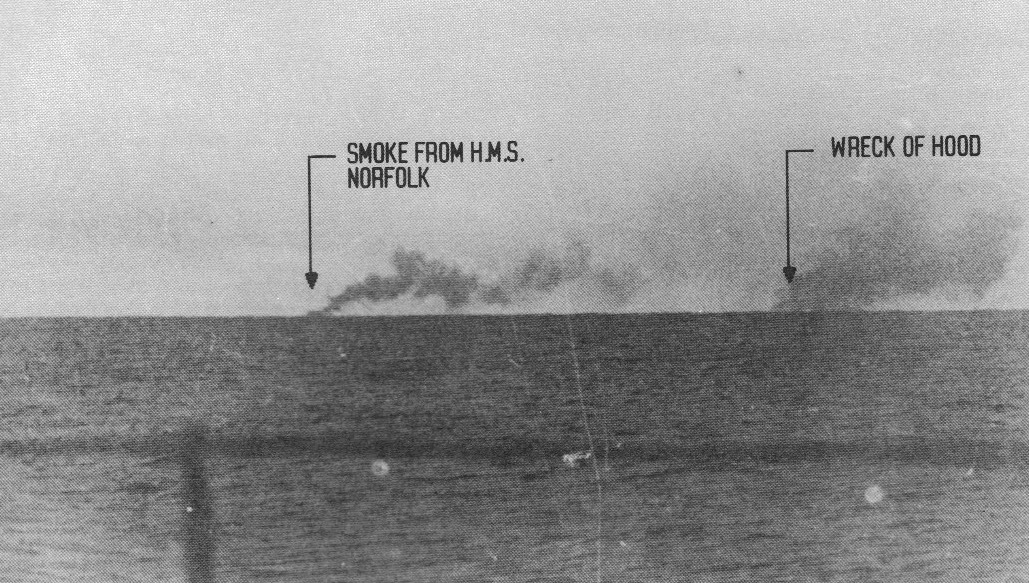
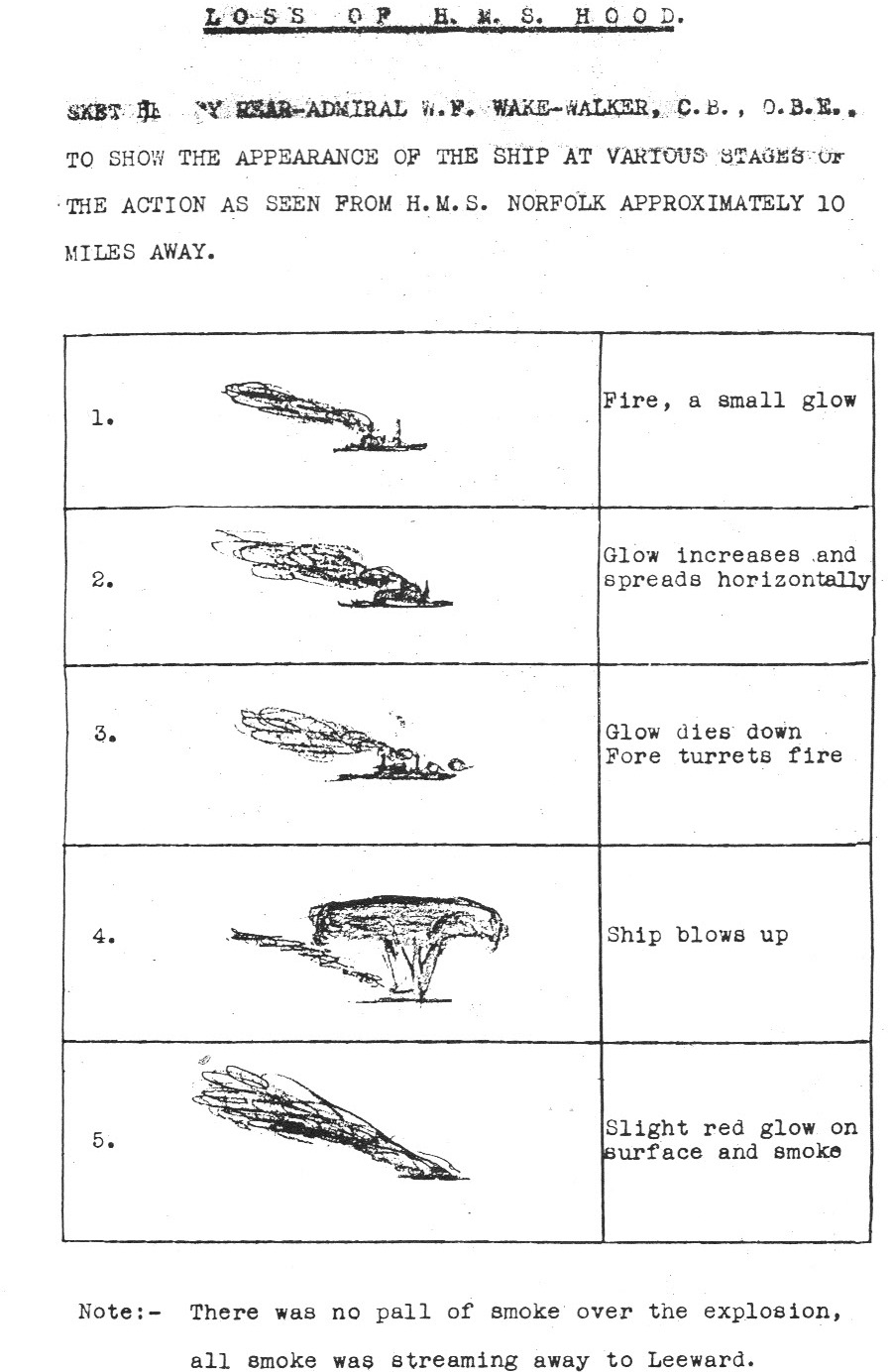
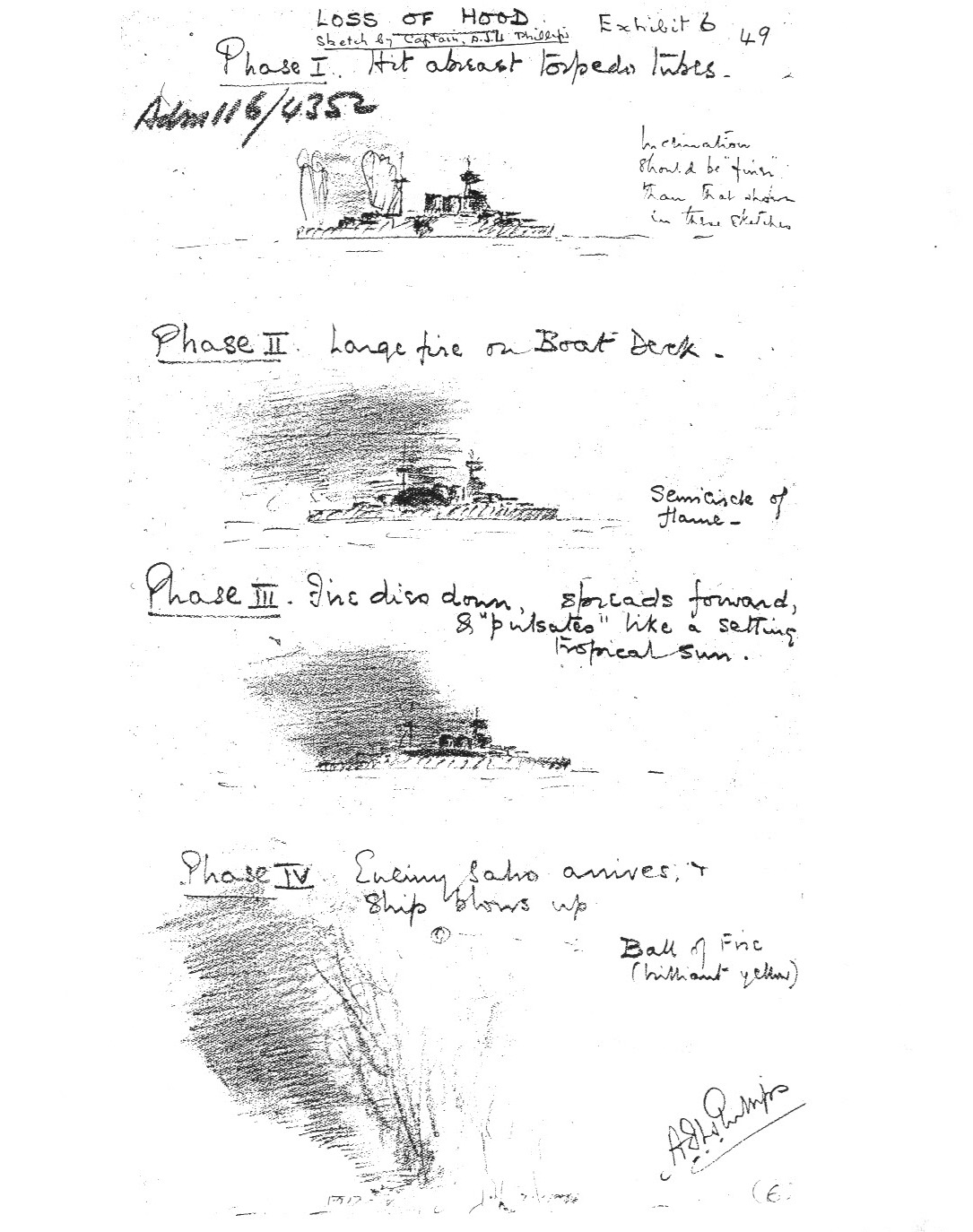
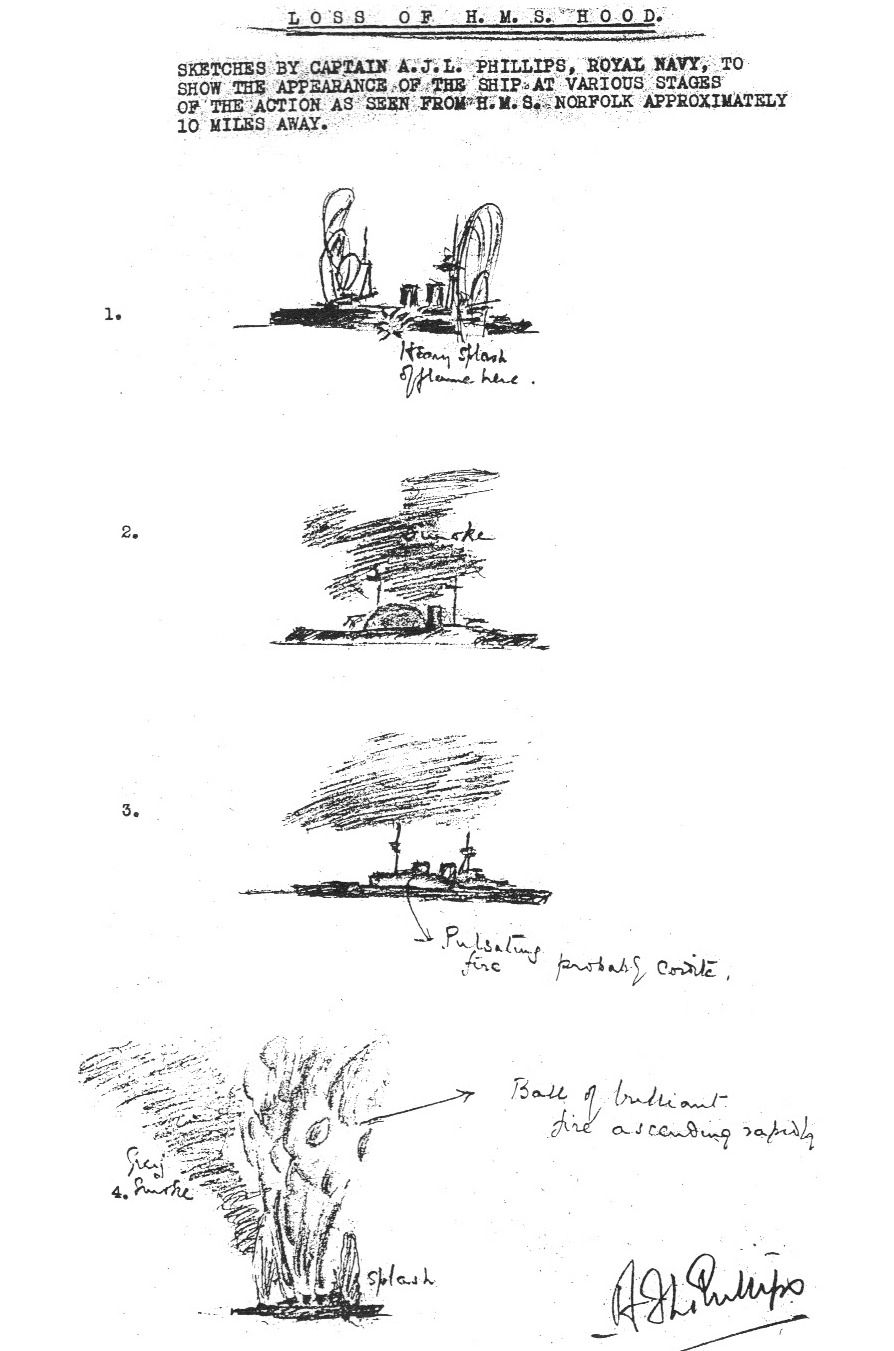
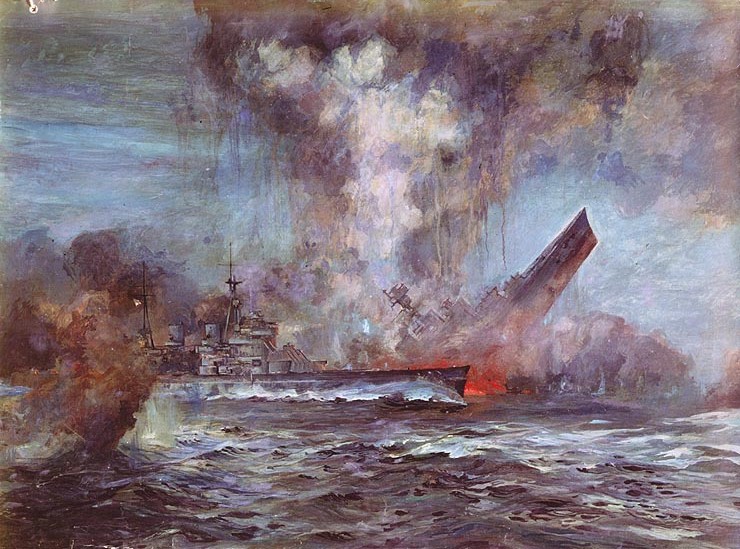
The Admiralty announced the loss of Hood at 9 P.M. on the 24th of May in the form of the following simple communiqué:
"British naval forces intercepted early this morning off the coast of Greenland German naval forces including the battleship Bismarck.
"The enemy were attacked, and during the ensuing action H.M.S. Hood (Captain R. Kerr, C.B.E., R.N.) wearing the flag of Vice-Admiral L.F. Holland, C.B., received an unlucky hit in the magazine and blew up.
"The Bismarck has received damage and the pursuit of the enemy continues."
Adding in a final poignant sentence:
"It is feared there will be few survivors from H.M.S. Hood."37
Thousands of British sailors and citizens recalled receiving the news as the single greatest shock of the war. Several officers recalled decoding the message again and again, in the absolute certainty that an error must have been made. The story hit the papers the next day. NAZI BATTLESHIP BISMARCK SINKS THE HOOD IN NORTH ATLANTIC DUEL; BRITISH GIVE CHASE; RAF FLIES TO CRETE, BLASTS 14 AIR TRANSPORTS read the verbose headline in the New York Times for Sunday the 25th. Describing Hood as a symbol of British naval power and the ". . . show ship of the British Navy," the paper called the action the greatest naval victory of the war since the River Plate. The Times of London carried the story matter-of-factly on page 4 of the edition of Monday the 26th, calling it ". . . the heaviest blow the navy has received in the war," and in an editorial entitled "The Price of Sea Power" characterized it as a ". . . heavy calamity." German communiqués, which were remarkable for their lack of self-congratulation, stated simply that Hood had been sunk in a five minute engagement between a German flotilla and heavy English naval forces, and that the Germans had received no damage worthy of mention in return - a not unreasonable assessment at the time.
It wasn't long before British recriminations began. A writer to the Times of London, in a letter entitled "DESIGN OF THE HOOD NO MISCALCULATION -The Handicap of Age" stated the Hood had not been destroyed by a "lucky hit" but because ". . . she had to fight a ship 22 years more modern than herself. This was not the fault of the British seamen. It was the direct responsibility of those who opposed the rebuilding of the British Battle Fleet until 1937, two years before the second great war started. It is fair to her gallant crew that this should be written."38 The Admiralty, still reeling from the shock of the loss, chose to file the letter as part of the official record.
It is clear that the Admiralty responded to the loss about as rapidly as circumstances allowed. In a letter to the Controller and the First Lord, Sir Dudley Pound wrote on 28th May:
"The loss of HOOD from internal explosion after a few minutes' action at 23,000 yards is disturbing, as we thought that the defects in construction which led to the similar loss of three capital ships at Jutland had been eliminated. . . . Now, after the lapse of 25 years, we have the first close action between one of our capital ships and that of the Germans since the Battle of Jutland and the HOOD has been destroyed in what appears to the onlooker to be in exactly the same manner as the QUEEN MARY, INDEFATIGABLE and INVINCIBLE, in spite of the action which was taken subsequent to Jutland to prevent further ships being destroyed as a result of 'flash'. . . . In the light of this experience, will you please have the whole matter re-opened, going back to the records of the last war and see whether any theory can be evolved that would explain the loss of all four ships from some cause other than 'flash'."39
Sir Dudley's letter set in motion the activities of the first inquiry to investigate the causes of the loss, convening on 30 May 1941 and headed by Vice Admiral Sir Geoffrey Blake."40 The results of the board, a two page report signed by S.V. Goodall, and classified "SECRET," were made available to V.C.N.S. and First Sea Lord on 2 June, 1941, only nine days after the loss and only a week after Prince of Wales returned from Hvals Fjord.41 The report began:
"This report contains the findings of the Court, but not the evidence on which these findings are based. Hence, some of the points raised in the following remarks may have been dealt with in the evidence and the Court's conclusions reached after full consideration of such points."
With some qualifiers, the report found that ". . . a 15-in shell fired from 'Bismarck' at the range and inclination of the fatal fifth salvo could, if lucky and if possessing sufficient delay, reach the after magazines," noted that the explosion seemed to originate at the base of the mainmast, and stated, "It is extremely difficult to associate this observed fact with the explosion of the 4-in magazines, the forward bulkhead of which group is 64 ft abaft the center of the mainmast." Almost unbelievably, as an alternative, the board felt that even a single torpedo head exploding in its confined box ". . . would most probably break the ship's back and result in rapid foundering." The report concluded:
"It is important the doubts concerning the loss of this ship should be cleared up if possible at a very early date, as although action is being taken to implement the lessons of both explanations, it is impossible to do this quickly for all our old capital ships if the true explanation is found by the Court. Moreover, it will never be possible to give these ships such protection to their magazines as to ensure certainty [sic] that modern shells and bombs under all circumstances that may exist in modern actions cannot reach their magazines."
Not surprisingly, when one considers the speed with which it was prepared, the report was rather incomplete. Although Goodall made this clear in the introduction, it was nonetheless criticized quite severely by some of the recipients.
In a memo dated 18 July 1941, V.C.N.S. wrote:
"D.N.C. in his minute on this paper raises a point of great importance, i.e., as he points out the report contains the findings of the Court, but not the evidence on which those findings are based. . . . it unfortunately transpired that no shorthand notes of the evidence were taken.
"This matter of the blowing up of the HOOD is one of the first importance to the Navy. It will be discussed for years to come and important decisions as to the design of ships must rest on the conclusions that are arrived at. This being so, it seems to me that the most searching inquiry is necessary. . . . I regret to state that in my opinion the report as rendered by this Board does not give me confidence that such a searching inquiry has been carried out; in particular the failure to record the evidence of the various witnesses of the event strikes me as quite extraordinary. . . . I also note that of the three survivors from the HOOD one only was interviewed. This strikes me as quite remarkable.
". . . I propose, therefore, that a further Board of Inquiry should be assembled as soon as possible and that the necessary witnesses should be made available. At this enquiry every individual in every ship present who saw the HOOD at or about the time of the blowing up should be fully interrogated."42
To that end, a second board of inquiry, headed by Rear Admiral H.T.C. Walker R.N., began hearings in August of 1941, delivering its final report on 12 September. Not surprisingly, the second report was much more thorough than was the first, taking evidence from a total of 176 eyewitnesses to the disaster, including 71 from H.M.S. Prince of Wales, 89 from H.M.S. Norfolk, 14 from H.M.S. Suffolk, and 2 from H.M.S. Hood, the third survivor, Midshipman W.J. Dundas being ". . . not available to give evidence to us."43 In addition, evidence was taken from two officers who had recently served aboard Hood, and from a number of other technical witnesses nominated by the Director of Naval Construction, the Director of Naval Ordnance, the Director of Torpedoes and Mining and the Chief Superintendent of the Research Department. In summary, the general findings of the second board of inquiry were as follows:
- The signal for the final turn 20° to port was flying at the time of the blast, but never executed.
- The fire was started on the port side of the boat deck of Hood by the 3rd or 4th salvo from Bismarck. The preponderance of evidence suggested that it was a cordite fire from U.P.44 and possibly 4-in ammunition in the vicinity. The fire on the boat deck had nothing to do with the final explosion.
- Evidence as to the seat of the explosion was divided between before and abaft the mainmast with a bias towards the former. The large explosion, which was visibly similar to magazine explosions aboard World War I battlecruisers, was due to the explosion of the after magazines.
- A large majority of witnesses heard little or no noise of the explosion.
- Very few witnesses could be very definite about the debris from the explosion, and 'a large number of small pieces' best described the general impression.
- The ship sank in three minutes or less.
- Evidence generally indicated that the salvos from Bismarck in the order they fell could be described as: 1) ahead, 2) astern, 3) straddle with hit, 4) close short, 5) probable hit. One salvo of 8-in H.E. was also noted astern of Hood.
- The explosion or detonation of torpedo warheads was of low probability, and at any rate could not have been the cause of the loss.
- If the muzzle velocity of Bismarck's guns was between 830 and 930 meters per second then a 380mm penetration to the main magazines was "quite possible"; if over about 930 meters per second, then the probability was "considerable." [The actual initial velocity of Bismarck's guns was c. 820 mps.]
- An effective underwater hit was relatively unlikely due to the c. 75 foot [23 meter] fuze delay required to reach the magazines.
The nineteen page report concluded:
- That the sinking of the HOOD was due to a hit from BISMARCK's 15-in shell in or adjacent to HOOD's 4-in or 15-in magazines, causing them all to explode and wreck the after part of the ship. The probability is that the 4-in magazines exploded first.
- There is no conclusive evidence that one or two torpedo warheads detonated or exploded simultaneously with the magazines, or at any other time, but the possibility cannot be entirely excluded. We consider that if they had done so their effect would not have been so disastrous as to cause the immediate destruction of the ship, and on the whole we are of the opinion that they did not.
- That the fire which was seen on HOOD's boat deck, and in which U.P. and/or 4-in ammunition was certainly involved, was not the cause of her loss.45
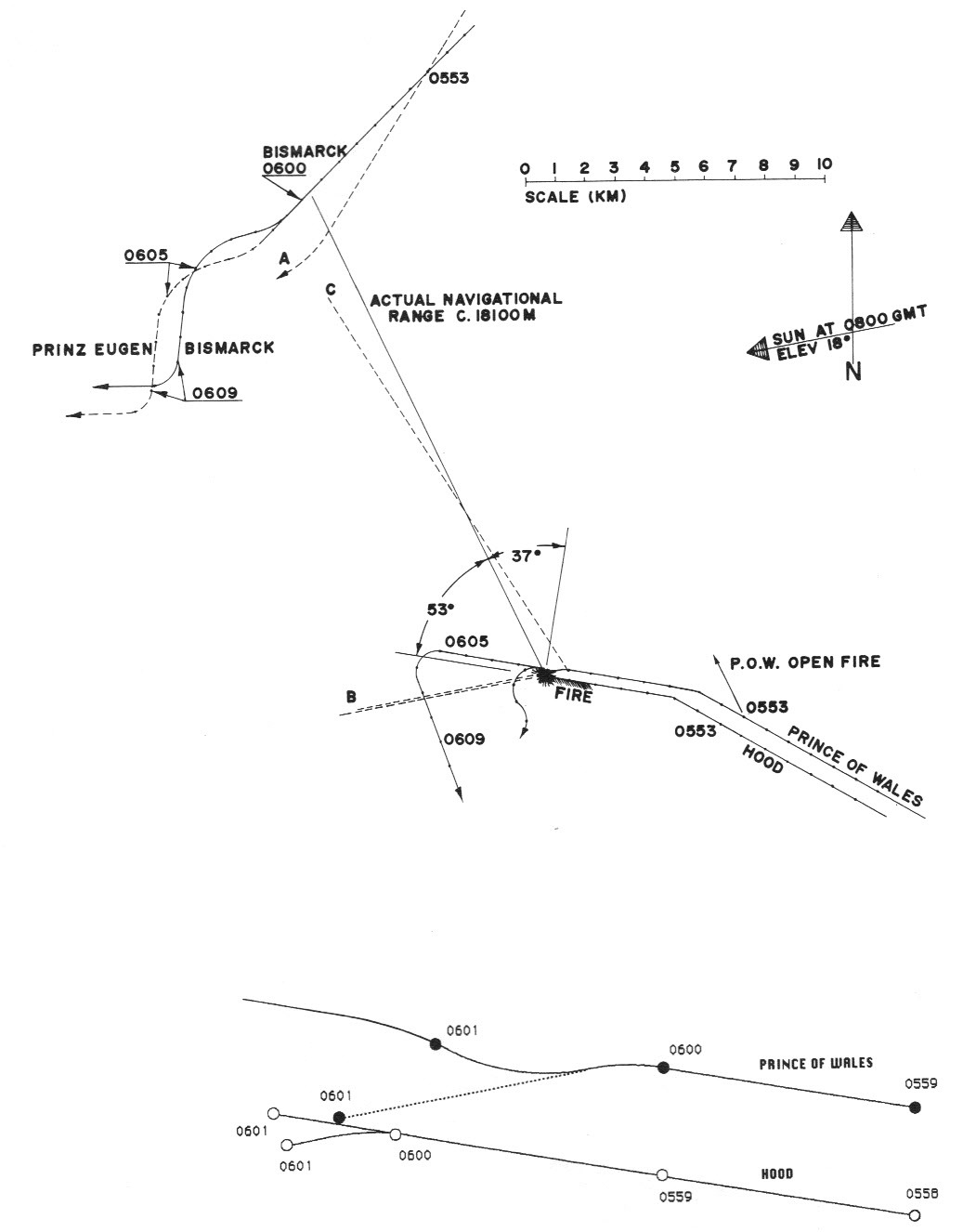
There are a number of possible explanations that might account for the loss of the Hood. A projectile from Bismarck may have penetrated her main belt and reached a magazine. Alternatively, a shell may have gone over the main belt instead, or reached the magazines by passing underneath. Some authors have suggested that it was a projectile from Prinz Eugen which caused the loss, or advanced the hypothesis that Hood was destroyed by the explosion of her port or starboard torpedo tube nest. Still others have proposed that it was an uncontrollable spread of the fire on the boatdeck that lead to her loss, that perhaps a loading accident was to blame, or that the blast was caused by unsafe or unstable propellant. Was the loss caused by one of these causes, several working together, or some entirely unrelated circumstance? I have begun by assuming that any reasonably credible explanation of the loss must meet most or all of the following criteria. First, it must be consistent with the observations of the eyewitnesses. Second, it must be physically plausible, in the sense that it is consistent with the normal laws of physics. Third, it should be of such a nature as to have had a reasonable probability of actually taking place. To that end, in order to reach my conclusions, I have undertaken both a careful and critical re-reading of the entire minutes of both boards of inquiry into the loss of the Hood, and re-assessed these observations as seen in the light of information unavailable to the original investigators.
Any discussion on the loss of the Hood must make it clear at the outset that there are important inconsistencies as to the range and target angle of Hood at the time she was hit. Published statements of the range, for example, range from an apparent low of 14,500 yards [13,260 meters], given in Raven and Roberts, to an apparent high of 19,685 yards [18,000 meters] given in Müllenheim-Rechberg.46 Although in more elementary treatments some of this is no doubt due to confused reading of accounts by writers making no distinction between "gun range," i.e. the range set on the sights of the guns to obtain a hit, and "navigational range," the geometric distance between the firing ship and the target, discrepancies in more knowledgeable presentations are difficult to explain. Even official track charts have proven inconsistent and unreliable. The track chart shown below, which was developed with the aid of a computer, has been redrawn from information taken from a large number of British and German sources and is, so far as I know, the first to reconcile all of these outstanding discrepancies. Geometric reconstruction of the various accounts indicates that the most probable range at impact was in the vicinity of 18,100 meters. Given this information, accurate figures for the appropriate terminal conditions of Bismarck's shells can be inferred from contemporary German range tables.
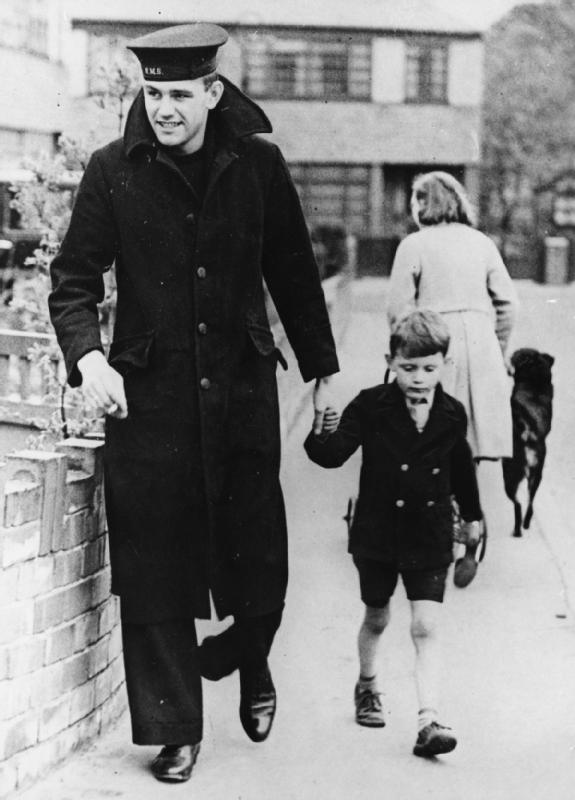
There are also major difficulties in determining Hood's exact target angle at the time of the blast. Some descriptions of the action suggest that Hood was either in the midst of completing her turn of 20 degrees away or that she had in fact completed it when the fatal explosion occurred.47 Witnesses in Prince of Wales, including Captain Leach and Cdr. Rowell, were consistent however in affirming that although a 2 blue was flying, it had yet to be executed when Hood blew up. The boards of inquiry specifically found that the final turn was never executed. The turn would have only taken about twenty seconds to complete, however, and there is at least circumstantial evidence that Hood might indeed have at least begun to turn when she exploded. Numerous witnesses confirmed that Prince of Wales had to alter course to starboard to avoid wreckage of Hood as she steamed past. It is very unlikely that such a maneuver would have been required unless Prince of Wales had already commenced a turn of 2 blue herself. Assuming that Hood and Prince of Wales maintained the normal practice of turning together and recalling that Hood was flag and thus controlled the movements of both British ships, it is clearly unlikely that Prince of Wales would have begun the turn without receiving an 'execute' signal from Hood. In my own opinion, the most probable explanation is that Hood had just begun the final turn, perhaps without yet sending the execute signal to Prince of Wales, and that Prince of Wales began the turn by reflex, in effect completing Hood's intention at the exact moment she exploded. In fact, both of Hood's surviving witnesses who gave detailed testimony stated that a turn to port had just begun when the explosion occurred. In describing the final seconds of Hood, Able Seaman Tilburn stated ". . . we started turning round to port and we were hit somewhere, and the whole ship shook and a lot of debris and bodies started falling all over the deck." Briggs confirmed this, stating ". . . it was either just immediately after or whilst we were doing this turn to port that the explosion took place." When asked if the execute signal had been made before the explosion, Briggs replied "I am not certain but I think it had."48
Although the testimony of eyewitnesses can give an overall picture of the circumstances leading up to the loss of Hood, such evidence cannot hope to establish the cause of the loss in detail. Not only was the incident itself rather poorly - almost casually - observed, but the dynamics of the event itself necessarily took place so quickly or in such locations that they were literally beyond the grasp of human perception. In such circumstances, the anecdotal accounts of witnesses can be used only to narrow down the range of possibilities, and to form a rough guide as to the most likely routes for further investigation. The final explanation must of necessity be technical in nature, and be reached via a scientific approach. The remainder of this paper will devote itself to a technical evaluation of the evidence available.
Initial data concerning the details of German guns and the armor of Hood has been relatively easy to obtain. Reference to Hood's cross section (see Part 1) shows that her belt armor was made up of three main sections, an upper belt 127mm thick, a middle belt 178mm thick, and a lower belt 305mm thick.49 Each was sloped 10° from the vertical with the bottom edge inboard to further increase its effective resistance. The deck armor is also shown in the cross sectional view. A range table for Bismarck's 380mm main battery over the ranges of interest is shown in Table II and a drawing of one of Bismarck's 380mm projectiles50 is shown further below.
| Projectile Weight | Initial Velocity | Range (meters) | Angle of Fall (deg.) | Time of Flight (sec) | Striking Vel. (mps) | Prob. Error (meters) |
|---|---|---|---|---|---|---|
| 800 kg | 820 mps | 14,000 | 9.9 | 20.7 | 581 | 49.5 |
| 14,500 | 10.0 | 21.7 | 575 | 50.0 | ||
| 15,000 | 10.5 | 22.4 | 569 | 50.4 | ||
| 15,500 | 11.0 | 23.3 | 561 | 50.9 | ||
| 16,000 | 11.5 | 24.2 | 556 | 51.3 | ||
| 16,500 | 12.2 | 25.0 | 550 | 51.8 | ||
| 17,000 | 12.8 | 26.0 | 544 | 52.3 | ||
| 17,500 | 13.3 | 27.0 | 537 | 52.7 | ||
| 18,000 | 13.9 | 28.0 | 532 | 53.2 | ||
| 18,500 | 14.5 | 29.0 | 527 | 53.6 | ||
| 19,000 | 15.0 | 30.0 | 520 | 54.1 | ||
| 19,500 | 15.8 | 31.0 | 515 | 54.5 | ||
| 20,000 | 16.4 | 32.0 | 510 | 55.0 | ||
| 20,500 | 17.0 | 33.0 | 507 | 55.5 | ||
| 21,000 | 17.8 | 34.0 | 502 | 56.0 | ||
| 21,500 | 18.3 | 35.0 | 498 | 56.5 | ||
| 22,000 | 19.0 | 36.2 | 492 | 57.0 | ||
| 22,500 | 19.9 | 37.3 | 489 | 57.5 | ||
| 23,000 | 20.7 | 38.4 | 485 | 58.0 | ||
| 23,500 | 21.3 | 39.5 | 482 | 58.5 | ||
| 24,000 | 22.0 | 40.6 | 478 | 59.0 |
There is a good possibility that a simple penetration of Hood's belt and/or deck armor may have initiated the events that caused the loss of the ship. The arrangement of the armor dictated that even if Hood had been engaged directly from abeam, the minimum obliquity of impact would have been c. 24°, equal to the 14° angle of fall plus the 10° slope of the armor. An analysis of the track charts of the action indicates that at the fatal moment, assuming she had not begun the final turn, Hood's target angle would have been approximately 53°.52 For this angle, corresponding to a shot approaching from 37° forward of the beam, the resolved obliquity would have been approximately 43.85°.53 German armor penetration curves, redrawn below,54 indicate that at the predicted striking velocity of 530 meters per second, the penetration for an intact projectile into face-hardened armor would have been approximately 240mm. An intact penetration of the 305mm main belt would therefore have been improbable, although either of the thinner sections would have been easily perforated. Calculations yield an exit velocity of about 450 meters per second from the 127mm plate and 365 meters per second from the 178mm plate.55 The impact would have certainly decapped the projectile and forced it to exit closer to the normal than its impact angle, meaning that the projectile might well have been traveling nearly horizontal and nearly athwartships, as it left the plate.
Depending upon the exact location of the hit, a shot perforating the 127mm belt would still have to penetrate approximately 160-180mm of deck armor in order to reach the magazines. If the hit went through the 178mm belt instead, only about 130mm of deck penetration would have been required, but in compensation the shell would have been traveling much more slowly. In either case the trajectory of the projectile, its velocity, and its high obliquity would have rendered useful penetration to the area of the magazines highly unlikely.56 Even assuming the projectile were not rejected or deflected by Hood's deck armor, the fuze delay of the German projectiles would have probably detonated the shell before it could reach a magazine. Assuming that the required deck penetrations reduced the projectile's average velocity to half of the plate exit velocity, a nominal fuze delay of 0.035 seconds corresponds to a travel of only eight meters at best, not enough to reliably reach a magazine.57 The German penetration diagrams are reproduced below.
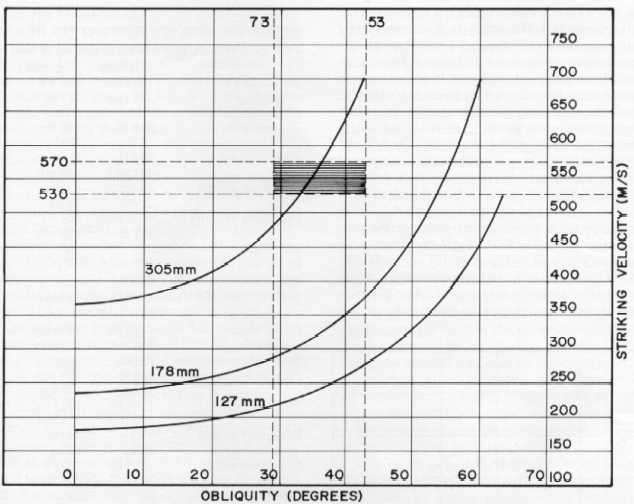
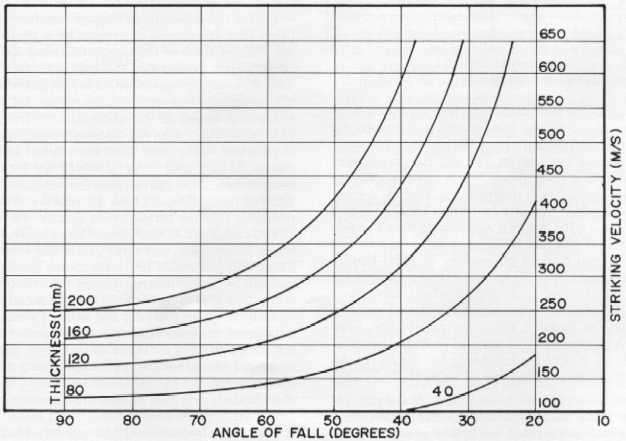
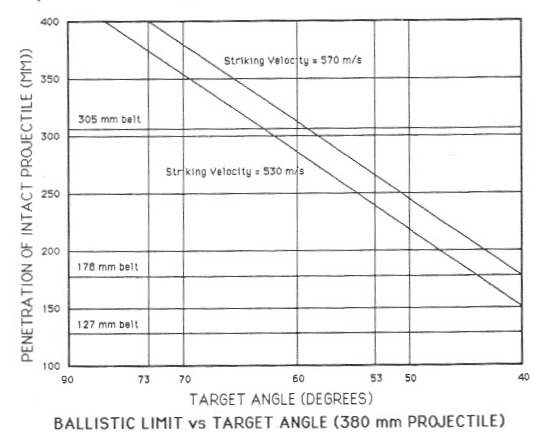

Perforation of the belt would have become much more probable as Hood passed further and further into the turn. Had the final 20° turn been completed, the target angle would have been about 73°, and the consequent resolved obliquity only about 29°. A close inspection of the armor penetration diagrams and the application of modern armor penetration theory shows that even Hood's 305mm belt could have penetrated if she had completed more than half of her planned final turn of 20 degrees to port. Unless the turn had been virtually completed however, it is not considered likely that a projectile which penetrated the main belt would have maintained sufficient velocity and integrity to make a magazine penetration probable. A comprehensive table of probable penetration conditions at both the beginning and the end of the turn is reproduced below in Table III.58
| Total Obliquity | Armor Belt | Projectile exit velocity | Projectile condition | Plug Weight | Plug Velocity | Fragment Weight | Fragment velocity | Exit angle | Horiz. exit component | Vert. exit component |
|---|---|---|---|---|---|---|---|---|---|---|
| 44° (Beginning of Final Turn) | 5" | 1,052 fps 321 mps |
intact | 269 lbs 122 kg |
986 fps 301 mps |
48 lbs 22 kg |
- | 32° | 64° | 6° |
| 7" | 608 fps 185 mps |
intact | 405 lbs 184 kg |
818 fps 249 mps |
65 lbs 29 kg |
- | 16° | 77° | -2° | |
| 12" | none | broken (?) | none | none | none | - | none | none | none | |
| 28° (End of Final Turn) | 5" | 1,295 fps 395 mps |
intact | 269 lbs 122 kg |
- | 35 lbs 16 kg |
1,295 fps 395 mps |
28° | 74° | 13° |
| 7" | 1,092 fps 333 mps |
intact | 389 lbs 176 kg |
- | 48 lbs 22 kg |
1,092 fps 333 mps |
27° | 74° | 13° | |
| 12" | 457 fps 139 mps |
intact | 723 lbs 328 kg |
- | 27 lbs 12 kg |
457 fps 139 mps |
15° | 81° | 3° |
It is clear from this information that Hood may indeed have been destroyed due to the action of a projectile which penetrated her belt. But a shell need not necessarily have penetrated the belt to destroy her. It might have gone over her armor belts. Or it might have gone under.
Both British Boards of Inquiry considered the possibility that Hood was destroyed by a projectile which fell slightly short of the target, and, after travelling some distance underwater, penetrated the hull and then detonated well below the waterline. This hypothesis is often associated with a similar underwater hit suffered by Prince of Wales in the same action. This damage was not discovered until the ship was drydocked some time after the action, and therefore the exact time and range at which the hit was scored is uncertain, although because the projectile apparently entered the hull from about 45° relative, it seems most probable that the hit occurred shortly after Hood was destroyed. Prior to that time, Prince of Wales was not under 380mm fire, and shortly after that time she turned away and presented her stern to the enemy. The hit, caused by a 380mm projectile from Bismarck, first contacted Prince of Wales about 8.5 meters below the waterline. After piercing the skin, it penetrated four additional internal light bulkheads before ending up nose forward just outboard of the ship's main torpedo bulkhead alongside the main engineering spaces. This hit certainly had the potential to destroy the ship had it exploded, and had it struck adjacent to the magazines.
Especially because it appears that the Germans made no specific effort to enhance the underwater capabilities of their projectiles, this represents a truly remarkable performance. Although the detailed underwater trajectory of any individual projectile remains difficult to predict with any precision, the general principles governing the underwater trajectories of most standard projectile types are relatively well understood. The usual tendency of an ogival headed projectile impacting the water at an angle of fall of about fourteen degrees would be to travel about eighty calibers submerged in an upwardly curving path, and to re-emerge once again with its velocity greatly diminished. The projectile would normally penetrate to a depth of about six calibers during its underwater run, corresponding to a depth of about 2.28 meters for Bismarck's 38cm shells. Provided the windscreen remained attached, which would be atypical, a mathematical treatment59 yields a trajectory radius of about 110 meters for Bismarck's shells, with a maximum depth of the trajectory of approximately 2.3 meters (c. 6.1 calibers) and a corresponding run to emergence of approximately 44 meters (c. 115 calibers). For a projectile of this type, therefore, penetration to a depth of 8.5 meters, or more than 22 calibers, is remarkable. Only the Japanese "suichu dan" projectiles, which were designed specifically to maximize their underwater performance, would be expected to approach this capability - in technical terms their practical lift coefficient seems to have been only about 0.11, corresponding to a trajectory radius of about 325 calibers. Such a projectile striking at an angle of fall of 12° would typically be expected to penetrate to a depth of about 18-20 calibers (6.85-7.6 meters) after an underwater travel of about 110 calibers (41.8 meters). At that point it would be expected to have retained about half of its original striking velocity.
In order to achieve this performance, the suichu dan projectile was designed with a specially weakened windshield and armor-piercing cap which broke away upon impact with the water and which presented the flat nose which is typical of projectiles designed for effective underwater penetration. Although the German projectiles used by Bismarck did not have the special breakaway windscreen and cap characteristic of the Japanese diving projectiles, they were equipped with a rather brittle aluminum windscreen and a fairly flat faced 'knob and ring" armor-piercing cap design. It is therefore quite possible that if the windscreen were removed by water impact, the comparatively flat armor-piercing cap may have accidentally approximated the effects of the suichu dan design.60 In fact a broken windscreen surrounding a knob and ring cap might by chance have formed what a hydrodynamicist commonly calls a "stagnation cup" at the nose, a shape well known for its underwater stability.61
Even had this taken place however, there remains some doubt concerning the action of the projectile fuze. The fuze delay of the standard German projectiles of the time was approximately 0.035 seconds, which at the range at which Hood was struck corresponds to a distance of only about 19 meters even if the projectile were traveling in air. Because of the additional retarding force, the equivalent distance under water would be much less - certainly less than 17 meters, and probably closer to 13 or 14. At the angles of fall which concern us here, this corresponds to a depth at detonation of something less than 3.5 meters. Assuming a fuze delay of 0.070 seconds, or twice the nominal,62 results in an underwater travel of from about 19.5 to 31.1 meters depending upon one's (rather arbitrary) assumptions about the shell's underwater behavior. If the trajectory were relatively straight, this corresponds to a depth of from about 4 to 7 meters. Insofar as Hood's belt projected only about 960mm below the water line, even a projectile with a "normal" underwater trajectory could have easily struck beneath it, and penetrated well into the ship before exploding. The second board of inquiry obviously considered a penetrating underwater hit a distinct and dangerous possibility, and prepared a special drawing of Hood showing the wave profile along the side at a speed of 28 knots. At least in the stern of the vessel, this drawing shows that the effective "draft" of the ship at any point along the side might range between 10.5 meters just forward of the mainmast to only 9.5 meters just forward of 'X' turret. The drawing also shows that the main armor belt, with its lower edge located about 7.75 meters above the keel, would normally be covered by only from 1.75 to 2.75 meters of water. This was obviously a point of great vulnerability.
The investigators who examined the fuze of the dud projectile which had struck Prince of Wales found that it had been actuated, probably upon water impact, but that shortly thereafter the powder train ". . . went out." This is not surprising when one considers that shells not specially designed for stable water entry quite commonly experience transient yaws exceeding 90° within the first twenty or so calibers of underwater travel. It is in fact possible (though improbable) that the projectile which struck Prince of Wales penetrated the water normally, rotated nearly 180° shortly after impact, and stabilized base first for the remainder of its journey. Such violent rotation would almost certainly have rendered the fuze inoperative, though after it was completed the flat base might have acted like a suichi dan nose. The fact that the projectile was recovered nose forward in the bilges tends to support this somewhat unusual hypothesis.
Provided the fuze operated correctly, however, an underwater hit represents one of the most plausible explanations for the loss of the ship. Projected upon the ship's cross sections, a projectile with an angle of fall of 10.6°-13.9° striking about 6 meters short could have penetrated the hull just below the 308mm belt and penetrated almost unimpeded directly to the area of the after magazines. On the not unreasonable assumption that unarmored ship's structure along the path would have approximately the same retarding characteristics as water, the nominal fuze delay range of from 0.035 to 0.07 seconds places the likely point of detonation squarely in the after magazines. The views below show the areas of vulnerability on Hood at the beginning and end of the turn.

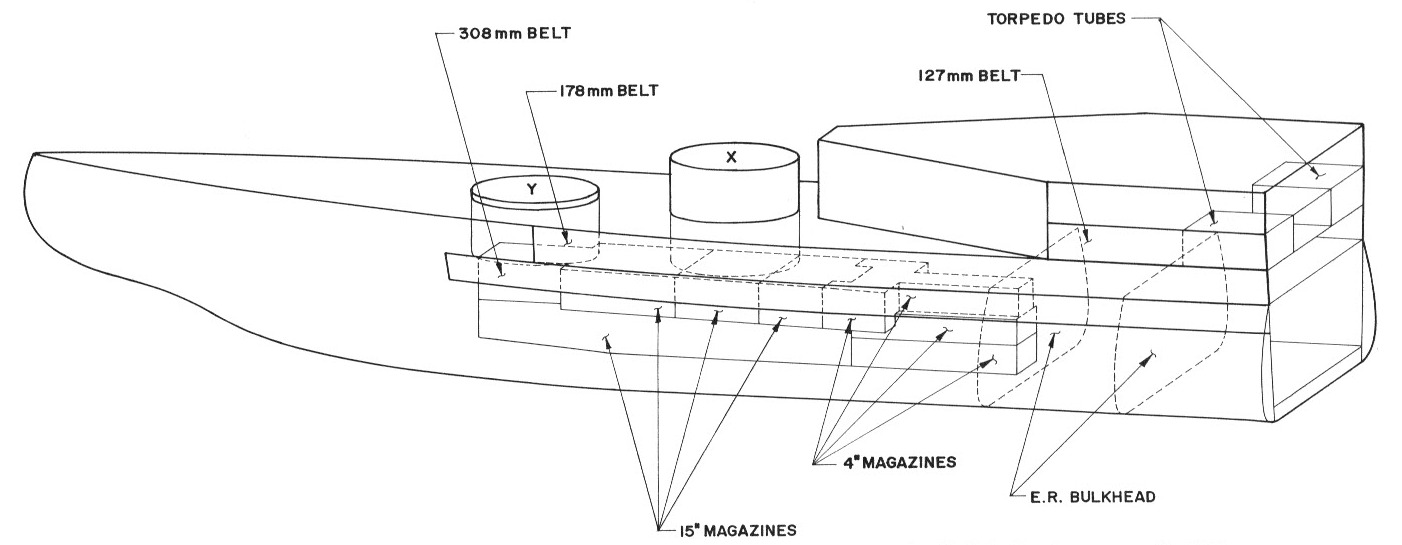
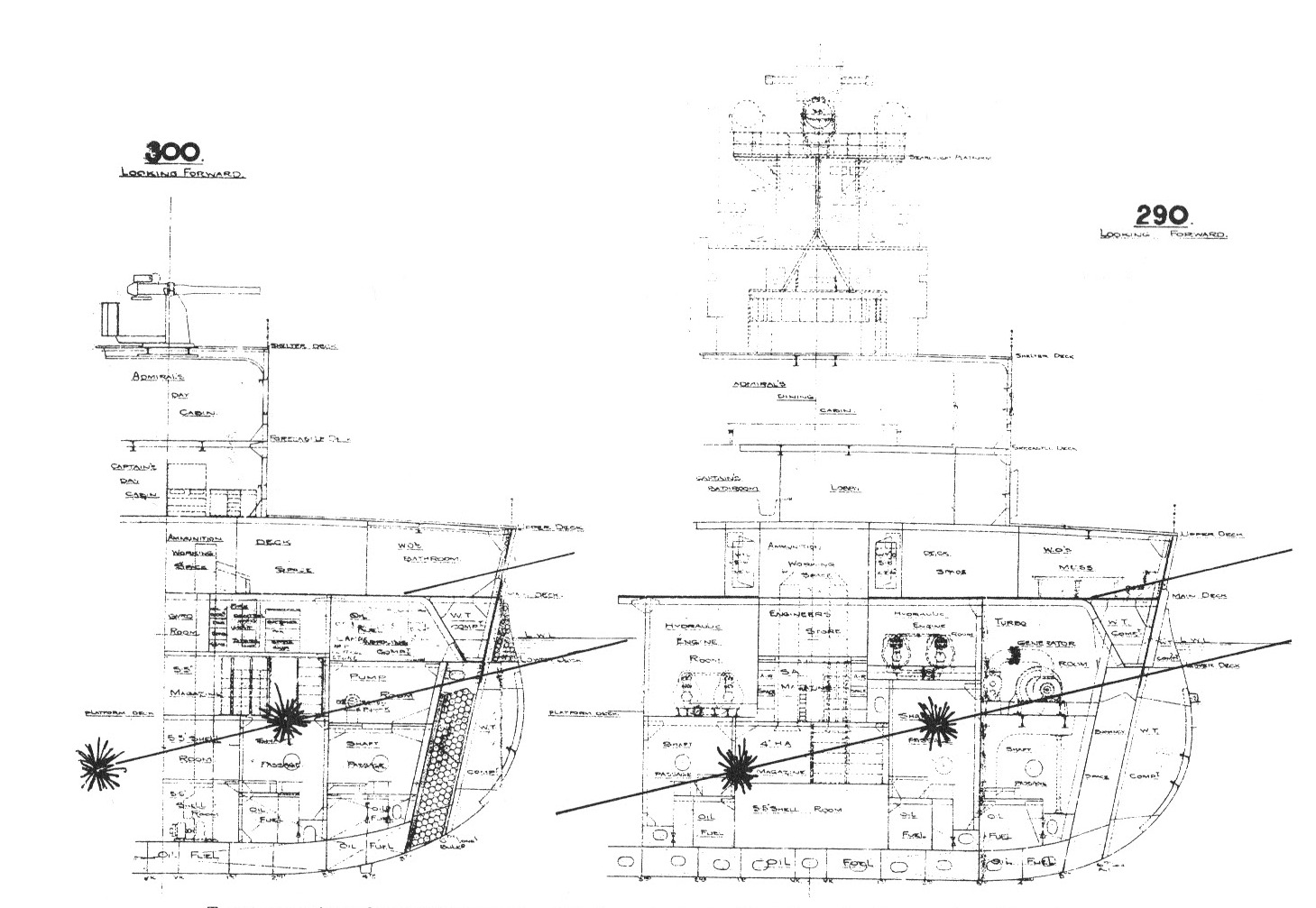
The boards of inquiry located, and most accounts since then have also mentioned, a band of potential weakness about 450mm wide located slightly above the probable waterline, and stretching from frame 259 to frame 280, i.e., abreast the after engine room. In this area, they considered it possible that a projectile could reach the area of the magazines by passing just over the top of the 305mm belt, penetrating the 178mm belt, and sneaking in just under the flat protective main deck by striking the portion of the deck that sloped down to meet the side. Assuming that the angle of fall of Bismarck's shells was somewhere between 10.6° and 13.9° and that the target angle was 53°, when superimposed on a cross section of the Hood, this corresponds to a resolved angle of between 13.2° and 17.2°. Searching the cross sections from the ship's plans at this angle of fall (instead of the 20° resolved angle of fall assumed in the Board's investigations) indicates that such an event, though not impossible, would have been rather improbable.
As noted above, it is also possible that the fatal projectile may have reached the magazines by passing over the belt, rather than under it. An attractive byproduct of this hypothesis is that it also lends itself to an easy explanation of the observation of witnesses that the fatal explosion seemed to originate in the vicinity of the mainmast rather than amongst the after magazines. As the orthographic diagrams above show, one plausible route for a projectile heading toward the after magazines and passing over the belt takes it in the immediate vicinity of the starboard torpedo tube nest. Because of the mantlet armor, a projectile traveling this path would not have been capable of detonating a torpedo, but it still might have done collateral damage along the way. There was an obvious fire on the boat deck, and perhaps one under the boat deck as well, in the vicinity of the torpedo tubes. If the shell or collateral fragments from the hull had perforated a charged torpedo air flask, for example, the result - especially in an area where an extensive fire was in progress - could have been a spectacular burst of flame around the mainmast, followed a split second later by the detonation of the after magazines. This is, in fact, exactly what many witnesses observed.63
Unfortunately it does not appear likely that a projectile from Bismarck could have penetrated to the magazines under these conditions. The angle of fall of the incoming shells was only from 10.6° to 13.9°, which is a very high obliquity for deck penetration indeed. Graphs of German armor penetration for the 380mm shell (see previous page) stop at an obliquity of 20° and must be extrapolated to obtain any figure at all for an obliquity greater than this. Further, the best estimates obtained by such extrapolation seem to yield a total penetration capability of only about 65mm. The total thickness of deck armor protecting the magazines in this area, admittedly distributed amongst several layers, amount to approximately 120mm. On average, penetration via this route, especially by a damaged projectile, is therefore considered unlikely.
It has however been suggested that a projectile striking over the engineering spaces could reach the forward bulkhead of the magazine group by penetrating both the 50.8mm forecastle and the 19mm main decks and then detonating between the main and lower decks just forward of station 280. The orthographic diagrams above reveal this to be an attractive alternative hypothesis.
Assuming that a penetration to Hood's magazines did in fact occur, it is worthwhile investigating exactly what the probable effects of a 380mm projectile hit on a 4-in or 15-in magazine might be. The Admiralty conducted a number of tests to resolve this issue, though it appears that none were specifically associated with the loss of Hood. The second board of inquiry, for example, took as evidence the results of trials conducted in 1936.64 This series of experiments concluded that the ignition of cordite of Q.F. cartridges by shell splinters would not blow up a Q.F. magazine, and that one 4.7-in shell detonated in contact with others would not result in a catastrophic explosion. When a 6-in C.P.C. shell loaded with shellite65 was fired directly into the magazine however, things were different. On the first trial, a shell fired into 98 rounds rack stowed resulted in ". . . a short pause followed by the complete disintegration of the magazine," and on the second trial, a shell fired into 94 rounds "box stowed" started a cordite fire that over a period of 48 minutes completely destroyed the magazine. In a confined space, a catastrophic explosion would have been probable. Heavy projectiles by themselves were much less vulnerable. Earlier trials had shown that ". . . The thick walled A.P.C. type of shell is practically immune from sympathetic detonation or explosion. A shell, bursting in contact with a pile of shells of this type filled 70/30 shellite and fuzed, may scatter the pile or even break up some of the shells in the pile without any of them exploding."66
A comprehensive British survey undertaken by the boards of inquiry covering twenty-two cases of war damage involving magazines, found only one case [4.5%] where the magazines had been known to explode, i.e., in Hood herself, six others [27.3%] where magazines were suspected to have exploded and fifteen cases [68.2%] where magazines had not exploded in spite of severe damage.67 Coupled with American experience, which seems to have indicated that catastrophic propellant explosions were rather rare even in cases where shells or bombs had detonated directly inside magazine spaces, this would seem to indicate that catastrophic explosions were rather rare.
It must be noted however, that British double-based propellants, which contained a substantial amount of nitroglycerine in their makeup, were significantly more susceptible to ignition than their single-base American counterparts. In 1945 the U.S. Navy Bureau of Ordnance conducted systematic tests to determine the susceptibility of various propellant formulations to accidental ignition.68 Using a nozzle mechanism capable of generating a reproducible flash, they found that while British Cordite type propellants would ignite while still some 530mm from the vent, standard American single base propellants would not ignite until the distance was reduced to 120mm, and the relatively new U.S. "SPCG" flashless powder, incorporating nitroguanadine, would have to be within 25mm of the nozzle before ignition took place. These are very substantial differences. Assuming the flame of the explosion to expand in a spherical front, the same explosion which would ignite one cubic unit of standard American powder, would be capable of igniting almost seventy-five times as much cordite. In the confined space of a magazine, the relative amounts of gas evolved, and the ensuing internal pressures could easily spell the difference between disturbance and disaster. Had Hood carried single base propellant instead of cordite, there is in fact a good possibility that the fatal explosion might never have occurred.69
A number of writers, including some members of the original boards of inquiry, have speculated that it was an explosion of torpedo warheads which directly or indirectly caused the loss of the ship. The Second Board of Inquiry itself concluded that though such an event was possible, it was not a likely scenario. The board concluded:
"Evidence of eye witnesses, REPULSE, and an Officer who had recently served in HOOD leaves little room for doubt that the mantlet doors were closed. A warhead could still, however, have been detonated or exploded by a direct hit from BISMARCK'S shell. There is no direct evidence that such a hit occurred, but it may have done so on either side of the ship. If a single warhead had gone off one other, but probably not more than one, the other warhead would also have gone off. . . . Expert opinion suggested that the explosion of two warheads would produce an all round almost instantaneous flash. It would not have produced the very high column of flame of appreciable duration, which was seen by so many witnesses. Nor was the noise, reported as being heard, compatible with that of a T.N.T. detonation or explosion. The consensus of expert opinion was definitely against the characteristics of the explosion as given in evidence by eyewitnesses being that of T.N.T."70
Sir Stanley Goodall, then Director of Naval Construction, held to a dissenting opinion, however:
"If one or more shells from the 5th salvo burst in this devastated area [where fire was already burning], where there are eight torpedo heads, four each side, each containing about 500 lbs of TNT at the base of the mainmast, and if one or more of these warheads detonated, the result would be an explosion where it was actually observed. Such an explosion could break the ship's back already weakened in this neighbourhood by the earlier damage. With the force on the after bulkhead of the engine room due to the ship's speed of 28 knots and the low reserve of buoyancy of the after part of the ship, this portion would rapidly sink. The foregoing is an alternative explanation of the occurrence which is as likely as the explanation in the finding of the court."71
Sir Stanley was probably wrong. Although no formal calculations were ever done, the court had looked long and hard into the issue, and received the testimony of a number of expert witnesses. Typical of these was Capt. John Carslake, R.N., an explosives expert who testified on Friday, 29 August. After confirming that although he was not an expert on cordite explosions per se, but that he ". . . knew a fair amount" about high explosive detonations, the court subjected him to a detailed examination.
"Would a 15-in or 8-in shell striking Hood's side abreast the torpedo tubes detonate a warhead with a pistol in it?" they asked. His answer, based on trials, was "No, not unless it penetrated and detonated inside the mantlet. If it detonated outside it would not detonate the warhead." "Would a direct hit, either from a shell or a splinter detonate a warhead without a pistol in it?" the court inquired. "If the shell detonated on impact with the warhead, it would detonate the warhead. If the shell hit the warhead but did not detonate, it would not detonate the warhead . . ." When asked what would be the probable effects if the warheads detonated, he replied:
"I would expect the mantlet, the ship's side, and the forecastle deck to be nearly demolished, but that the major venting would have been as I suggested horizontal. Immediately after the explosion it is anticipated that the observer would have seen a gap in the ship's side, probably some 15 or 20 ft. radius down to the top of the 12-in belt. . . . I would expect the boat deck above the tubes also to be blown away.72
B.A. Fraser, Controller, summarized his particular objections to the torpedo scenario in a memo dated 7th July:73
"D.N.C. has raised the question of whether the above water torpedoes in 'HOOD' were responsible for the destruction of the ship. I disagree with his view, and accept the report of the Board of Inquiry for the following reasons:
- from trials, a 15-in shell burst outside a torpedo tube protected by a mantlet will not detonate the torpedo.
- Although a direct hit may detonate one torpedo, it is extremely unlikely that others will be countermined. In 'KHARTOM' a torpedo was fixed74 into the after galley by an air vessel bursting. The head did not detonate but it burnt to detonation in the fire after a considerable period, about 20 minutes, and in 'HOOD' the interval between the first hit and the destruction of the ship seems to have been under 3 minutes.
These descriptions are consistent with the results of other experience. To take one example, on 26 December, 1943 the destroyer U.S.S. Brownson (DD-518) was struck by a Japanese bomb which apparently detonated one or more of the 374kg torpex loaded torpedo warheads in her after quintuple torpedo mount.75 The resulting explosion removed or completely demolished all ship structure over a radius of approximately 10 meters. Fifteen minutes later, Brownson sank. Although the detonation of a torpedo tube nest could result in the sinking of a destroyer in fifteen minutes, it is clearly unlikely to have caused the loss of a battlecruiser in three. The chances of a torpedo explosion near the mainmast detonating even the closest of the ship's magazines twenty-five meters and two decks away are inconsequentially small.
"The 4-in. ammunition supply doors in the ship were closed until the Captain passed the order 'supply 4-in. ammunition.' This organization resulted from an incident when the ship was bombed at the end of September or beginning of October 1939, as it was then found that 4-in. ammunition was being replenished before any order had been given. I can visually confirm that this procedure was rigidly adhered to as I was on the boat deck during the subsequent bombings of the ship and during the action off Oran. . . . The water-tight door organization was extremely thorough and efficient and was practiced every day at sea. All doors were marked in plain language."
With regards to the gasoline stowage, he testified:
When the ship proceeded to sea, all petrol, except approximately 2 gals, was left in the drifter. This was kept behind to enable the power boats to be started up on return to harbour. There was a special organization for landing a number of 50 gallon drums which were kept on the boat deck adjacent to the sea' lifebuoy abreast the mainmast. The quick release drums originally supplied to the ship were released into the sea and not recovered or replaced, on the first occasion of the ship being attacked by aircraft, about 3 weeks after the outbreak of war. The drums were stowed on trays and the stoker who looked after this stowage was so proud of his care that he told me he could not fill a petrol lighter."77
It would thus appear that the fire on the boat deck, though spectacular, probably played no direct part in the loss of the ship.
There has been considerable speculation that the fatal explosion could have been caused by a projectile fired from the main battery of Prinz Eugen. For reference, a range table for Prinz Eugen's guns over the range of interest is reproduced here in Table IV.
| Projectile Weight | Initial Velocity | Range (Meters) | Angle of Fall (Deg) | Time of Flight (Sec) | Striking Velocity (mps) | Prob. Err. (Meters) |
|---|---|---|---|---|---|---|
| 122kg | 925 mps | 14,000 | 11.00 | 21.3 | 483 | 64.5 |
| 14,500 | 11.95 | 22.4 | 472 | 65.0 | ||
| 15,000 | 12.8 | 23.4 | 463 | 65.5 | ||
| 15,500 | 13.8 | 24.5 | 451 | 66.0 | ||
| 16,000 | 14.5 | 25.7 | 441 | 67.0 | ||
| 16,500 | 15.5 | 26.9 | 431 | 68.0 | ||
| 17,000 | 16.5 | 28.1 | 424 | 69.0 | ||
| 17,500 | 17.5 | 29.5 | 417 | 69.5 | ||
| 18,000 | 18.6 | 30.6 | 408 | 70.0 | ||
| 18,500 | 19.7 | 31.9 | 400 | 71.1 | ||
| 19,000 | 21.0 | 33.2 | 394 | 72.5 | ||
| 19,500 | 22.0 | 34.6 | 388 | 73.2 | ||
| 20,000 | 23.2 | 36.0 | 383 | 74.0 | ||
| 20,500 | 24.5 | 37.3 | 378 | 75.0 | ||
| 21,000 | 25.9 | 38.7 | 372 | 76.0 | ||
| 21,500 | 27.1 | 40.1 | 370 | 77.5 | ||
| 22,000 | 28.7 | 41.5 | 367 | 79.5 | ||
| 22,500 | 30.1 | 43.0 | 363 | 80.4 | ||
| 23,000 | 31.5 | 44.6 | 360 | 81.0 | ||
| 23,500 | 32.8 | 46.2 | 358 | 82.8 | ||
| 24,000 | 34.1 | 47.8 | 357 | 85.0 |
Speculations concerning Prinz Eugen's shells usually revolve around the idea that although her projectiles would have had little or no chance of penetrating Hood's belt armor at the specified range and obliquity, due to their "plunging" trajectory, they might have set off the after magazines after penetrating Hood's relatively thinly armored decks. In support of this, one article purporting to reproduce a diagram of the relative trajectories of Bismarck's and Prinz Eugen's guns has been drawn so as to give an angle of fall exceeding 35 degrees.78 A quick examination of the range tables, however, shows that such an angle is highly exaggerated, to say the least. In reality, due largely to the higher initial velocity of Prinz Eugen's guns, at the range at which Hood was engaged the angles of fall of both Bismarck's and Prinz Eugen's guns were remarkably similar. Over the ranges of interest, the angle of fall of Prinz Eugen's projectiles was only about 13°-19°, an angle which cannot in any meaningful sense be construed as "plunging fire." Further, the striking velocity of Prinz Eugen's shells could not have exceeded about 460 meters per second. Even assuming that the shells could have found a spot to hit the deck directly, at the calculated angle of fall the official German armor penetration curves for this gun, though not reproduced here, allow them a penetration of only about 40-60mm of homogeneous armor at best. In fact, as was the case of the 380mm gun, the curves for these conditions are effectively "off the graph," strongly implying almost no possibility of intact penetration at all. Even at the closest possible range, belt armor penetration at the calculated obliquity of 47° would have only been about 100mm for an intact projectile and 103mm for a broken one, both of which are well under the thickness of even Hood's uppermost and thinnest belt.
Although a hit from Prinz Eugen could possibly have caused the fire in Hood's after superstructure, it would have been almost impossible for such a hit to have penetrated to the after magazines.79 Prinz Eugen may have been able to hurt the Hood, but she would almost certainly be unable to kill her.
Most observers were confident that the fatal explosion seemed to originate in the vicinity of the mainmast, in a position well forward of the after magazines. There is, of course, a possibility that Hood was hit by more than one projectile in a single salvo. If this were the case, then a shell hitting and detonating in the area of the mainmast a split-second before another penetrated farther aft could explain the impression of most observers that the explosion began farther forward than it actually did. As will be demonstrated below, however, the chances of such a sequence of events are not high. As a near approximation, the percentage of hits to be expected on moderately sized normally maneuvering targets in well-aimed naval gunfire can be roughly described by the equation:
Ph = 10(E-TX)
Where:
In which we express X as a percentage of maximum range in order to render the equation dimensionless. In the formulation above, 100% hits occur at 0% range and a variable number of hits occur at 100% range. That 100% hits occur at 0% range is true almost by definition, but the percentage of hits occurring at maximum range (i.e., at 45° elevation) is somewhat more difficult to define. For most normal situations, the equation is most accurate when T is selected as being equal to 0.023, equivalent to 0.5% hits at maximum range.80
The maximum range of Bismarck's guns taken from published range tables is normally approximately of 35,500 meters. This figure corresponds to only a 30° angle of elevation however, as Bismarck's guns could not elevate any higher. Computer simulations however, show that the 45° maximum range would have been in the immediate vicinity of 41,700 meters. Taking this figure as the maximum range of Bismarck's guns would mean that Hood was at about 36% of maximum range when she exploded. At that range, the equation would yield approximately 15% hits.81
U.S. Navy fire effect tables from 193582 give 0.235 hits per gun per three-minute period for the 14-in/50 gun at 16,000 yards [14,630 meters], a roughly equivalent situation. Assuming one round per gun per minute, this is equivalent to a hit percentage of 0.235/3 = 0.078, or 7.8%.
Other official figures83 give average four-gun pattern sizes for U.S. 14-in and 16-in [350mm and 406mm] guns as approximately 190 meters at our range of interest. A very simple approximation, giving Hood a beam of 30 meters, would render a hit percentage in the vicinity of 30/190, or 15%.84
Bismarck's actual performance was in fact in rough agreement with these estimates. Up to the time Hood exploded, Bismarck fired five, four-gun salvos, and achieved between one and three hits, giving her a raw hit percentage of about 2/20 or 10%. In viewing this figure, however, we must remember that the five salvos she fired included at least two and possibly three to find the range, and also that Hood and Prince of Wales were making rather frequent course changes during the action, so that her hit percentage in aimed, well-ranged fire would probably have been somewhat higher.
Taking this and other factors into account, once Bismarck had found the range it would appear reasonable to grant Bismarck about a 10% - 15% hit probability during the final salvos she fired at Hood. A statistical analysis of four-gun salvos with a 10% single shot hit probability shows that about 64% of such salvos would result in no hits, 31% would result in one hit, 5% would result in two hits, and only about 0.27% would result in three. For a 15% hit probability, the figures are about 5%, 40%, 9%, and 0.8% respectively. Thus the chance of two simultaneous or near simultaneous hits on Hood leading to the visible effects accompanying the blast seem only to be about one in fifteen or twenty. The probability of more than two simultaneous hits causing the blast is negligible.
There remains another alternative, admittedly of low probability, that Hood might possibly have destroyed herself. Evidence is sketchy, but nonetheless does exist.
It is interesting to note that more than a third of the witnesses aboard Prince of Wales actually missed the fatal explosion itself. Further, of the approximately forty-five witnesses who observed the explosion directly, less than a quarter associated it with a specific fall of shot from the enemy. A further 22% associated the explosion with the firing of one of the after turrets, and fully 55% of the observers did not associate the explosion with anything at all - to them the ship just blew up. There is therefore at least a minor possibility that the final explosion had nothing to do with Prinz Eugen or Bismarck at all.
Several witnesses noticed - and chose to mention unusual events aboard Hood during the action. P.O. George Henry Goff, a layer-rating in the port battery in Prince of Wales' port-after director, testified that he saw the third salvo fall ". . . on the starboard side of the 'Hood,' very close. The next thing I remember was seeing flames from 'X' turret. 'A,' 'B,' and 'Y' were firing at the time and I noticed that 'X' turret was not firing. . . . The next thing I noticed was that the 'B' turret was firing but belching out flames. After that 'Y' turret fired on its own and 'Hood' went up." When queried in detail about the belching flames, he replied, somewhat opaquely, "When a gun fires the flash licks slowly round the muzzle of the gun. But there was no straight flash and the flames licked slowly round." The board dismissed his testimony with the statement "This witness is rather inclined to be imaginative."85
But others had noticed a similar phenomenon. Through his periscope, Petty Officer James Crowley, captain of Prince of Wales' P.4 turret, noted ". . . when I looked through the periscope again I saw a flame come from 'B' turret through one of the guns. Not many moments after that she blew up."86 P.O. Edgar Holt saw the same thing through the periscope of P.5. turret. ". . . a fire broke out abreast 'X' turret on 'Hood' [sic] port side," he said. "About two minutes later I saw a flame about 10 feet long shoot out of 'B' turret muzzle and about a half to one minute later 'Y' turret on 'Hood' fired her first salvo. About a second later, 'Hood' blew up."87
Others also observed something unusual with 'Y' turret. Petty Officer Lawrence Sutton saw the action from the port side of the Admiral's shelter deck on Prince of Wales. ". . . Hood was firing with her foremost turrets," he said. 'Y' turret had been trained fore and after during this time. 'Y' turret then trained towards the enemy and before firing there was a flash abaft the mainmast of the 'Hood' which appeared to be a fire on the boat deck. 'Y' turret then fired," he continued, "and at the same time a huge flash came up all around 'Y' turret. The flash rose to well above the mainmast of the ship and all I heard was a tremendous roar and I could not see anything until the smoke had cleared away. That was all I saw of the 'Hood'." The court considered the memory of what he saw "very confused."88 A number of other witnesses confirmed Sutton's observations. At least one clearly saw Y turret train toward the enemy, return again to its fore-and-aft position, and train upon the enemy again.
To what can we ascribe this unusual performance? Could Hood have been encountering internal difficulties with her supply of powder and shell? Could some failure have disrupted the notoriously complex and often unreliable sequence of anti-flash mechanisms installed after British experience at Jutland?89 In the urgency of combat, might someone in the turret have over-ridden a balky anti-flash interlock in order to bring the turret back into operation? Might there have been something wrong with Hood's propellant? Could a failure of her gas ejection system have caused a flare back into 'Y' turret which thence blew up the ship? Are these scenarios all merely wild speculation? These possibilities, though unlikely, cannot be positively excluded.
The exact origin of the explosion is now, and shall probably always remain, somewhat in doubt. An examination of the actual testimony of witnesses shows that although a preponderance felt that the explosion came from forward of Hood's mainmast, this opinion was by no means universal. Statistically, about 42% saw the explosion as originating forward of the mainmast, 16% saw it originating at the mainmast, and 21% either saw it originating aft of the mainmast or someplace else entirely. Some witnesses associated the explosion with a fall of shot from Bismarck, but, as we have seen, a very significant proportion did not.
Given the conflicting and confusing evidence that has been presented, is there nonetheless a "most probable" explanation for the loss of Hood that reconciles the observations of witnesses with the geometry of the ship, and with the course of the action? I believe there is. The first significant bit of evidence is that to most witnesses the blast was essentially noiseless, or at least lacking a noticeable "bang." The "bang" of an explosion is caused by the creation of a supersonic shockwave, and is necessarily absent when burning occurs, even very rapid burning indeed. The noiselessness of the explosion constitutes strong circumstantial evidence that the fatal blast was caused not by the detonation of Hood's shells or torpedoes but by the more or less rapid combustion of her propellants. It is probably no coincidence that a very similar noiselessness was associated with the explosion of USS Arizona's propellant magazines at Pearl Harbor. This conclusion is in accordance with the findings of the original boards. Assuming that a shell or shells from Bismarck precipitated the disaster, this also explains the short delay that witnesses noted between the arrival of Bismarck's fatal salvo and the first evidence of the blast, and may in fact explain why many did not causally connect the two events. The burning rate of typical gun propellant is closely related to the surrounding pressure and temperature, and except in a very tightly enclosed space - such as the breech of a gun - take a considerable time to "build up steam." In fact, if venting is adequate, most gun propellants are surprisingly hard to ignite and unspectacular in their combustion.
In the absence of any other possible energy source, like the boards, I have concluded that it is most probable that Hood was relatively slowly rent apart over a period of perhaps a second by the uncontrolled burning of the propellants in her after magazines. Although the actual position of the hit and the subsequent path of the projectile through the ship are problematical, it is clear that there are several routes by which one of Bismarck's 380mm shells might have reached the after magazines. Again, like the boards, I have also concluded that the most probable cause of the final blast was a hit from a single 380mm projectile from Bismarck.
The general consensus of witnesses was that the explosion seemed to originate in the vicinity of the mainmast, some distance forward of the after magazines. The orthographic diagram shows that there is one place where a shell falling slightly short could have passed through the after engine room and detonated in or near the magazines located immediately adjacent to its after bulkhead at station 280. Yet another possibility is that it passed through the 178mm belt before detonating in essentially the same place. If this occurred, and ignition of the propellant in the magazines followed from it, then a large part of the rapidly expanding gas bubble would have taken the path of least resistance and vented into the engineering spaces immediately forward of this area. For a time the sheer inertia of Hood's structure would have slowed expansion in any other direction. Once the expanding gasses had reached the engine rooms, the quickest exits to the outside would have been the series of massive exhaust vents located on the centerline immediately forward and aft of the mainmast. These huge ducts, changing in size and shape as they rose through the ship ended in roughly square vents 1.8 meters on a side on the boat deck. It was as spectacular, near-vertical columns of flame from these vents near the mainmast, foreshortened to observers on surrounding ships, that the explosion first became visible. Shortly thereafter, the entire stern of the ship exploded.90
At the time of the blast, the Boards of inquiry calculated the "X" 15-in magazine contained about 49 tons of cordite, "Y" magazine contained 45 tons, and the 4-in magazines contained about 18.5 tons. The uncontrolled burning of this quantity of propellant in the after magazines might have slowed briefly as the volume of the engineering spaces served as a space into which the gasses could expand, and as the vents directed much of the combustion products outboard. But although this expansion and venting could temporarily relieve the pressure, it could never be enough to prevent an explosion from eventually tearing the ship apart.91 Ironically, the chemical energy stored in the battlecruiser's after magazines - enough to lift her enemy over a kilometer in the air had it been employed to do so - had instead destroyed the Hood herself.
Until relatively recently, this paper might have been considered definitive. But today, there is still more work that might be done. We live in a marvelous age, an age when men have once more set foot upon the Titanic. It is therefore entirely possible that curious - and we hope considerate - men will gaze upon shape of "Mighty Hood" again. No one can know with certainty what they might find. But only then, if ever, will it be possible to write the final chapter in the checkered life, and the spectacular death, of H.M.S. Hood.
This program, which I have developed myself, and which is still in the developmental stages, analyzes the entire gunfire problem from the muzzle to the post impact behavior of the projectile on the target. The program uses a series of complex and accurate algorithms to compute the percentage of hits to be expected on the target at various ranges, the proportion of hits on each exposed surface of the target's armored box, and the number of penetrations based on the U.S. Navy's WW II armor penetration equation given in ORD SK78841 [More details on this equation and its derivation are given in Nathan Okun's article '"Armor and Its Application to Warships - Part III," Warship International No. 2, 1979, pp. 284 et. seq.]. At this preliminary stage, the program assumes the armor suit of the target to be a simple box with single plate sides, ends, and deck.
Assuming the initial values for Hood's armor to have been 200mm, 178mm, and 127mm, respectively, it is easy to vary the thickness of the deck armor and compute equivalent values for the thickness of the belt and ends while keeping the overall displacement the same. This results in the values shown below in Table V.
| Deck Thickness (mm) | Side Thickness (mm) | End Thickness (mm) | Total Weight (tons) |
|---|---|---|---|
| 100 | 229.2 | 143.0 | 8,789 |
| 120 | 205.8 | 129.0 | 8,789 |
| 125 | 200.0 | 125.0 | 8,789 |
| 140 | 182.5 | 114.0 | 8,789 |
| 160 | 150.2 | 99.0 | 8,789 |
| 180 | 135.8 | 84.9 | 8,789 |
| 200 | 112.5 | 70.3 | 8,789 |
Computing the hit percentages and the number of penetrating hits that Bismarck might be expected to score on Hood over the range band from 15,000 - 25,000 meters at 1,000 meter increments, using optical fire control, and target angles from 0° to 90° in 30° increments, results in the graph shown below. What is important here is not the absolute number of penetrations that are scored, but the relative number of penetrations that occur as deck thickness varies.
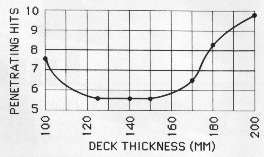
The graph clearly shows that in this particular situation the minimum number of penetrations occurs with deck thicknesses between about 125 and 150mm. It is also interesting to note that increasing the deck thickness beyond this value is actually counterproductive. Even though the algorithms used for armor penetration are admittedly approximate, they do indicate that rather than being too thin, Hood's decks might have been just about ideal for the situation in which she found herself on the 24th of May. Incidentally, the program also predicts that Bismarck would have been expected to score approximately 10.1% hits on Hood at a nominal range of 18,000 meters and a target angle of 60°.92
This article was first published in 1987. In the period since this article was originally published, there have been several tentative plans made, and abandoned, to utilize modern technology to dive to Hood's wreck. Although such an expedition might be interesting from an historical viewpoint, it is unlikely that it could do more than to confirm that the after magazines exploded - a point which is universally acknowledged already. It is, in any case, extremely unlikely that an examination of the wreckage would reveal any significant details regarding the exact circumstances surrounding the loss. The Naval Institute Press has recently published a book "The Bismarck Chase" by Robert J. Winklareth which covers the loss of Hood in some detail. The bibliography reveals no reference to primary sources and - in the absence of further coorborative evidence - the author's conclusions might best be viewed somewhat skeptically. Although Mr. Nathan Okun has somewhat refined the armor penetration algorithms originally used in this analysis, it does not appear likely that the application of the updated equations would substantively change the conclusions previously reached.
Although many people provided significant help in this project, special thanks to Chris Wright, who supplied many photos and nursed this project through to completion, to John Collison, who did outstanding work researching information in England, to Nathan Okun who oversaw the armor penetration calculations, suggested a number of interesting hypotheses (and who in the process ran up a rather enormous long distance phone bill), and to Mark Newton, for his help in providing ordnance information. Very sadly, Paul Schmalenbach passed away just as the first draft of this manuscript arrived.
Many thanks are also due to Mr. Harry Purdue, Chairman of the Hood Association, and to Mr. James Brown of Cheshunt, Herts, who were able to answer many questions, and who supplied, amongst other things, a complete list of those lost in the tragedy.
- ADM 116/4351, "CASE 6762 - Loss of H.M.S. Hood in action with German Battleship Bismarck in the Atlantic on 24th May, 1941." 440 pp. Public Record Office, Kew, Richmond, Surrey
- The official record of both boards of inquiry.
- ADM 116/4352
- A continuation of the above record, primarily comprised of duplicate illustrations and the actual shorthand notes of the court reporters. 467 pp.
- Bradford, Ernie, The Mighty Hood, Hodder and Stoughton, 1959, 224 pp.
- A readable, if popularized, account emphasizing the operational history of Hood from her construction to her loss.
- D'Eyncourt, E., H.M.S. Hood, Engineering, March 26, 1920
- Detailed technical description, with many interesting illustrations, but dated when compared with modern sources.
- Grenfell, Russel, The Bismarck Episode, Faber and Baber, 1960
- A well-written, basic account of the entire sortie of Bismarck and Prinz Eugen.
- Kennedy, Ludovic, Pursuit - The Sinking of the Bismarck, William Collins Sons & Co. Ltd., 1974
- Probably the best "all round" account for the hunt for the Bismarck.
- Müllinheim-Rechberg, Baron Burkhard Von, Battleship Bismarck - A Survivor's Story, U.S. Naval Institute, 1980
- An interesting personal narrative of the German side of the action [Transcriber's Note: This book was revised and re-issued by the U.S. Naval Institute in 1990].
- National Maritime Museum, Greenwich, England. "As Fitted" drawings of H.M.S. Hood 1/8 in = 1 ft 0 in (1/96) scale, corrected to c. 1931
- Extremely expensive to obtain, drawings from the N.M.M. tend to be of inconsistent scale and are often poorly reproduced and incomplete. Sadly, in spite of the greatly increased quality of service which would result from such a move, the N.M.M. still refuses to supply microfilm copies of drawings in their collections.
- Newton, R.U., Practical Construction of Warships, Longmans, Green and Co., London, 1939
- A top-notch descriptive textbook describing the nuts and bolts detail of British construction methods between the wars. Although never specifically mentioned, many of the illustrations describing capital ship construction are actually of Hood.
- Northcott, Maurice, Hood: Design and Construction (Ensign Special), Bivouac Books, Plaistow Press, London, 1975
- Main focus on design and construction of Hood. Includes a separate eight page compilation of abstracts from the official boards.
- Oberkommando der Kriegsmarine, Unterlagen und Richtlinien zur Bestimmung der Hauptkampfentfernung und der Geschoswahl ("Basis and Guidance For the Determination of the Best Range and the Choice of Projectiles"), Berlin, 1940. Enclosure (A) to U.S. Naval Technical Mission to Europe report No.37245. Operational Archives Branch, U.S. Naval History Division.
- Raven, Alan, and Roberts, John, British Battleships of World War II, U.S. Naval Institute Press, 1976
- Chapter 4 deals specifically with the design of Hood, with many other references throughout. An excellent source of design information
- Roberts, John, Anatomy of the Ship: The Battlecruiser Hood, U.S. Naval Institute Press, 1982. 127 pp.
- A comprehensive technical description, with many outstanding illustrations.
- Schmalenbach, Paul, Kreuzer Prinz Eugen . . . unter 3 Flaggen, Koehlers Verlagsgesellschaft MbH, Herford, 1985
- An excellent account by the Assistant Gunnery Officer of Prinz Eugen. In German.
- Vielica, Ron, "Who Sank the Hood?" Sea Combat magazine, Spring, 1979, pp. 16-23 et. seq.
- Highly speculative and technically weak account which investigates the possibility that a shell from Prinz Eugen actually caused the sinking.
- Weldon, D.G., "H.M.S. Hood," Warship International, No.2, 1972, pp.114-157
- An excellent overall account with a good mixture of technical and operational details.
- ^1.11.2The immune zone may be defined as that area inside of which belt penetrations might occur, and outside of which deck penetrations are possible. Thus a target within the immune zone was, theoretically at least, invulnerable to penetration of the vitals, and in that sense "safe" from enemy fire. The zones listed are approximate, and are calculated against Bismarck's 380mm armor piercing bullet at a 90 degree target angle, using the thickest part of the belt to define the inner limit and 0.8 times the total deck thickness to define the outer limit. Hood's actual armor scheme was so complex that the computation of a regular immune zone is almost impossible. The 10° slope of the belt armor has been taken into account.
- ^The trials are described in C.B. 1561 "Progress in Gunnery Materiel - 1920," ADM 186/244 X/LO 1045 pp.82 et. seq. Progress in Gunnery Materiel - 1920 pp. 82 specifically states ". . .This addition to the main deck of H.M.S. Hood has been made, the extra weight being balanced by the removal of the torpedo control tower, four of the 5.5-inch guns, and all the above water torpedo tubes," but the author was obviously speaking before the fact. The tone of the statement shows how far the planning had progressed, however.
- ^All times given are Zone -2. Most details of the preamble to the final action are taken from Prince of Wales' "Narrative Of Operations Against Bismarck," ADM 116/4351 pp 392 et. seq.
- ^This abbreviation apparently refers to Admiral Holland, then in overall tactical command of Hood and Prince of Wales.
- ^The "blue pendant" refers to the signal flag that was used in association with other flags in order to transmit course change information. The color of the flag indicated the degree of change while the order of flags on the halyard indicated the direction. When the flags were lowered, the course change was executed by all ships simultaneously.
- ^It is difficult to understand how he can have expected so early a contact as, according to Grenfell, the rate of relative approach at this time was under 35 knots. Kennedy, however, states the relative rate of closure was almost twice this figure. As the ships maneuvered, the relative rates were changing almost minute by minute.
- ^In British service, one cable was nominally considered to be equal to 100 Fathoms or 600 feet. It follows therefore that 4 cables would equal slightly over 730 meters. Some reference books give a British cable as 608 feet instead, but the difference is entirely negligible.
- ^Grenfell discusses a number of alternative explanations for the seemingly poor British tactics. One is that Holland was following the informal instructions of his superior Sir John Tovey, who, observing that deflection errors were more common than range errors in target practice, suggested to many officers in his command that an end on approach was best when closing the range rapidly was of paramount importance and when "A" arcs would be closed in any case. A more likely explanation is that Holland was simply following the precepts of the Royal Navy's Fighting instructions taught at the Admiralty Tactical School between the wars, which apparently suggested just such an approach. See The Bismarck Episode, pp. 61-64.
- ^Hood's intercept course at 0553, provided the Germans did not maneuver to avoid, would have been c. 270°, with intercept about 0628, and would have given both the Germans and the British identical target angles and problems with 'A' arcs. Had the Germans turned away before intercept the battle would have turned into a duel of broadsides on parallel courses. Had they turned toward Hood and Prince of Wales could have neatly crossed their 'T.' At the time of initial contact, 0535, Hood's intercept course would have been about 268° with theoretical "collision" at 0633. Ironically, this would have closed the range at about 870 meters per minute, whereas the actual range rate in practice was only about 690 meters per minute, only a 25% improvement. Assuming Hood's supposed zone of excessive deck vulnerability to be 5,000 meters wide, this means that the extra traverse time would have only been about two minutes, roughly enough time for only two extra salvos to have been exchanged. Of course, as subsequent events were to make clear, it would take only one well placed salvo to kill.
- ^The footnote references and the explanatory material in square brackets have been added. The times were approximate. The board received a number of track charts of the action, but as Captain George Rowell, the navigating officer of Prince of Wales was to note with remarkable understatement, they:
". . . were compiled on the following day from the information available. Unfortunately, the plot where the narrative was being kept was thrown into some confusion by a large amount of blood that was pouring down from the compass platform onto the track chart."
- ^"A" arcs were said to be "open" when all main battery guns could bear on a single target forward of the beam, else "closed."
- ^ADM 116/4351 p.394. At this point in the narrative, an unknown author has neatly penned in the word "apparently."
- ^ADM 116/4351 p.210.
- ^These were almost certainly 203mm shells from Prinz Eugen's first salvo. Other observers made similar remarks, and particularly noted a salvo which appeared to fall roughly midway between the two British ships.
- ^ADM 116/4351 pp. 212.
- ^ADM 116/4351 pp. 261. Hood's frames stations in British terminology were spaced about 640mm (25.32 in) apart on average, so this point was about 175m (580 ft) aft of the bow, i.e., just aft of the after fire control tower. Although Rowell was sure that it was a 15-in salvo which caused the damage, he was almost certainly in error. As can be seen on board Exhibit "M", in order to have hit where Rowell indicated, the shell would have had to have passed through the fire control tower on its way, which almost certainly would have come to the attention of those on the bridge. Rowell's location for the hit is therefore probably in error as well.
- ^ADM 116/4351 pp. 218-220.
- ^ADM 116/4351 pp. 251.
- ^ADM 116/4351 pp. 225. The reference to the "after screen" and "screen doors" remains mysterious to me.
- ^ADM 116/4351 pp. 234.
- ^ADM 116/4351 pp. 236.
- ^ADM 116/4351 pp. 237.
- ^Presumably this was flame exiting from one of the large engine room exhausts located on the boat deck between the after control tower and the break of the superstructure. There were several skylights and ladderways in the area as well, but both of the ammunition hoists in this location would have presumably been screened from his view. A complete deck plan of Hood's boat deck showing all relevant detail is given in a number of places throughout the minutes of the various boards as Exhibit M.
- ^Tilburn's testimony is at ADM 116/4351 et. seq. A.B. Alfred James Priddy, in partial confirmation, stated that "The splashes of this salvo appeared to be smaller than the first two, and two splashes of this salvo were short," but Lt. Cdr. Rowell of Prince of Wales considered ". . . very definitely that it was a 15-in salvo." Although the court decided to side with Lt. Cdr. Rowell, the first hit on the boat deck was almost certainly scored by Prinz Eugen.
- ^ADM 116/4351 pp. 364 et. seq.
- ^The exact quote in the testimony is "Leave it until the ammunition had gone," but I have corrected the obvious error in syntax.
- ^Dundas's evidence before the first board of inquiry is summarized in ADM 116/4351 pp. 59. He was apparently not recalled to testify before the second board.
- ^ADM 116/4351 pp. 148.
- ^ADM 116/4351 pp. 198.
- ^Several accounts purport to describe various pieces of Hood which landed on Prince of Wales after the explosion. Upon close examination, all were proven to be parts of Prince of Wales herself, thrown about in various ways from shells that arrived aboard later in the action.
- ^Kennedy, pp. 87.
- ^ADM 116/4351 pp. 217. How he could be sure the last sound he heard was only gunfire, however, escapes me.
- ^ADM 116/4351 pp. 191.
- ^ADM 4351 pp. 218 et. seq. Brooks also testified "When the second hit was obtained on the 'Hood' the after funnel seemed to crumple over and fall away to the port-side and I saw a yellow flash come at the same time from the barbette of 'X' ". He indicated the source of this flash as being directly under the chase of 'X' guns at the position at which they were trained.
- ^Prince of Wales cut in front of Hood after she exploded, and turned away to port shortly thereafter, and her courses after disengaging, first 160 then 250 degrees, would not have brought her around behind the Hood again from the German point of view. The black smoke usually attributed to Prince of Wales in photographs is in fact most likely from Norfolk, which was in the appropriate position during the action.
- ^Bradford, pp. 186.
- ^Letter to the editor The Times, 28 May 1941, reproduced in ADM 116/4351 pp. 17.
- ^ADM 116/4351 pp. 14.
- ^The other members of the board were Capt. C.F. Gammel of H.M.S. President and Capt. C.H.J. Harcourt of H.M.S. Duke of York.
- ^The entire first report is given in ADM 116/4351 pp. 6-7.
- ^ADM 116/4351 pp. 10-11. The last three paragraphs of the memo have obviously been "patched on" from text prepared using a different typewriter.
- ^ADM 116/4351 pp. 89 et. seq. It is worthy of note that Norfolk was fifteen miles distant at the time of the blast, and Suffolk was nearly twice as far, so the evidence of the witnesses from these ships is rather general in nature.
- ^The abbreviation 'U.P.' stood for Unrotated Projectiles, i.e. rockets.
- ^The entire final report is given in ADM 116/4351 pp. 89-108. As a matter of interest, the board also listed their estimates of 90° immunity zones for British ships against German 15-in shell. In rounded metric units, these were: KGV class 13,700 - 31,000 meters, Nelson class 13,700- 32,000 meters, Queen Elizabeth class 16,450 - 25,150 meters, Royal Sovereign class 16,450 - vulnerable (18,750 meters with 25mm deck armor addition). Renown's immune zone was negative, with the belt limit at 25,600 meters and the deck limit at 21,950. The immune zone is the area far enough away from the enemy to prevent penetration of the belt armor, yet close enough in to prevent plunging fire from penetrating the deck.
- ^Other values are 16,500 yards [15,087 meters] quoted in both Roberts and Bradford, and 21,130 yards [19,300 meters] scaled from a track chart in Grenfell. Whitley [German Cruisers of World War II, U.S. Naval Institute, 1985] gives the ranges from Prinz Eugen to Prince of Wales as 24,500 meters at 0553 and 16,000-17,000 meters at 0559. Dulin and Garzke [Battleships - Axis and Neutral Battleships of World War II, U.S. Naval Institute, 1985] give the range from Bismarck as decreasing to 18,300 meters after the fatal shells had been fired, which implies the range was higher before that time. A track chart in Schmalenbach yields a range of c. 18,000 meters at the time of the blast. The official British track chart gives the range as 16,300 yards, i.e., 14,900 meters.
- ^E.g. Bradford pp. 184 and Kennedy pp. 86. Statements that Hood's 'A' arcs were closed up until that time were false. Drawings of the ship show that Hood's after turrets could train and fire within 30° of the bow, although her starboard turret rangefinder optics would have been 'wooded' by the after superstructure until an angle of 43° had passed. Official drawings of Prince of Wales show her after turrets could have engaged up to 45° from either bow. As Bismarck was bearing approximately 53° off the bow during the final run in, it is evident that both Hood's and Prince of Wales' 'A' arcs had in fact been well clear since the turn at 0555, provided one would have been willing to accept some damage from muzzle blast. Captain Leach's statements that Y turret would not bear probably mean that 'Y' turret would not bear comfortably.
- ^ADM 116/4351 pp. 360-365. Perhaps significantly, however, Briggs was equally positive that the turn was one of 40° instead of the 20° it actually was.
- ^These values have been converted and rounded to metric units, in Imperial units the thicknesses were 5-in, 7-in, and 12-in., respectively.
- ^As an aside, in the process of reviewing preliminary drafts of this manuscript, several readers took me to task for using "bullets" as a synonym for "shells" or "projectiles." Although I have thus deleted this noun from the paper, readers should note that it is not entirely unknown. For one example, see S.E. Morison, History of United States Naval Operations in World War II, Vol. XII. pp. 190 et. seq., "The proportion of 8-inch bullets in the heavy cruisers was 66 per cent."
- ^All range tables in this paper are derived from "Unterlagen" described in the bibliography.
- ^Strictly speaking the target angle is defined as the angle between the firing ship's bow and the line of sight to the target, an angle which is used to develop the lead angle used in surface gunfire. In the absence of a better term, I have used it here to describe the angle from which the projectiles from Bismarck actually arrived on the Hood. Hood and Bismarck would not have moved significantly with respect to each other during the approximately 28 second time of flight of Bismarck's projectiles.
- ^The equations to determine the resolved obliquity for a sloped armor plate are basic but are rarely reproduced. In simple terms Oo = Arcos[Cos(Fd) * Cos(Id) * Cos(Bpd - Rd) - Sin(Fd) * Sin(Id)], where Oo equals the resolved obliquity, Bpd equals the target angle, Id equals the inclination angle of the armor, Rd equals the rotation angle of the armor, basically its horizontal orientation within the ship, and Fd equals the angle of fall. Vide, Okun, Nathan "Frames of Reference," unpublished manuscript in the author's collection.
- ^Vide "Unterlagen und Richlinien . . ."
- ^As a first approximation, Yr = (V2 - VI2)0.5, where Yr equals the residual velocity, V equals the striking velocity and VI equals the limit velocity for the plate in question. These exit velocities were obtained directly from the German data, and thus do not exactly match the (more accurate) values given in Table II, and derived from more modern computations.
- ^Note that all the figures for armor thicknesses given here ignore the roughly 38mm thick backing plates and teak cushion behind the face hardened armor, a not insubstantial barrier that would reduce the penetration of impacting projectiles even further. Thus the penetration values given here, are, if anything, somewhat optimistic.
- ^When examining Hood's cross sections, an eight meter travel along the line of flight corresponds to an athwartships distance of only about 6 meters. Assuming a target angle of 53°, and that the projectile was undeflected by its passage through the armor, the ratio of actual travel to projected travel when superimposed on the ship's cross section is equal to cos 37°, or 0.7981. Of course, the projectile would have been deflected athwartship during penetration, so this may be looked upon as a minimum value. It is worth noting that the angle of fall would have been greatly reduced at the same time, which would have tended to keep the flight line above the crowns of the magazines.
- ^I am indebted to Nathan Okun for this table, who exercised considerable expertise and judgment in computing and checking the values therein.
- ^
All normal underwater trajectories are found to develop an upward curvature as the projectile slows. A rough approximation of this curvature is given by the equation:
R = 2m/p A Cl y
Where:
- m = Mass of projectile
- p = Density of fluid
- A = Area of projectile
- Cl = Lift coefficient
- y = yaw angle
It is interesting to note that neither the angle of fall nor the velocity of the projectile enters into this formulation. Of the quantities above, only the yaw angle and the lift coefficient are typically unknowns, it is therefore convenient to replace these with a single term, CIp, the practical lift coefficient, which can be selected to match the results of actual observations. For most projectiles, CIp lies in the range between 0.05 and 3.00 with most underwater trajectories corresponding to a practical lift coefficient of about 0.33. A comprehensive if complex treatment of practical underwater ballistics is given in May, Albert, "Water Entry and the Cavity-Running Behavior of Missiles," Nav/Sea Hydroballistics Advisory Committee Technical Report 75-2, Silver Springs, Maryland, 1975, 450 pp.
- ^It is known for certain that German windscreens could be detached on water impact, as one fetched up on destroyer Zulu while engaging Bismarck a few days later. This is not surprising when one considers that the instantaneous load on a windscreen upon typical water impact could well exceed fifty tons. In fact, during World War II, the U.S. Navy had difficulty with armor piercing projectile caps and windscreens coming loose through normal handling. A U.S. 16-inch projectile recovered from Casablanca Harbor in 1960 was found to be missing not only its windscreen but its armor-piercing cap as well.
- ^Other similar nose forms which serve the same purpose are known colloquially as "spades," "pickle barrels," and perhaps somewhat more officially as "kopfrings."
- ^Evidence from U.S. sources indicates that such an increase in delay would not be unusual. For example, U.S. Navy specifications for the Base Detonating Fuze Mark 21 considered the fuze action satisfactory if the detonation occurred between 0.030 and 0.070 seconds after impact when set for a nominal 0.033 second delay. British experience at the River Plate and elsewhere lead them to estimate the effective German fuze delay as being about 0.05 seconds.
- ^Captain William Weilcose Davies, who had left Hood less than a year before her loss, testified that the torpedoes would have been stowed with pistols installed if shipped in the tubes, and that spare torpedoes without pistols but with warheads in place would have been slung above the ready use torpedoes, with the nose section run into the protective mantlets.
- ^"Enclosure 'B' to D.N.O.'s Minute of .6.36 - Trials to obtain the effect of shell fire on 4.7" Q.F. fixed ammunition R.U. magazines" extracted in ADM 116/4352 pp. 386.
- ^"Shellite" was the British term for a mixture of picric acid and dinitrophenol, with approximately the same explosive power as TNT. See C. B01831 "Memorandum on Armour, Shells, Fuzes and Aerial Bombs, 1928," ADM 186/174 for more details.
- ^CB 1594, "PROGRESS IN GUNNERY MATERIAL, 1921," ADM 1861251 x/L00326. See also C.B. 01831, "MEMORANDUM ON ARMOUR, SHELLS, FUZED AND AERIAL BOMBS, 1928" ADM 186/174 ERD17626, describing complete trials with essentially the same results.
- ^The full list is given and discussed in ADM 116/4351 pp. 116-119. Evidence to support the second category was characterized as typically "scanty" in nature.
- ^Bulletin of Ordnance Information, No.245, pp. 54-60.
- ^I am indebted to John Howard Oxley of Halifax, Nova Scotia for bringing to mind the role that powder characteristics might have played in the disaster.
- ^ADM 116/4351, pp. 105-106.
- ^Raven & Roberts pp. 350-351. A variant of this memo, reaching essentially the same conclusion and dated 2 July 1941, appears in ADM 116/4351 p. 7.
- ^ADM 116/4351 pp. 385.
- ^ADM 116/4351 pp. 8.
- ^This is obviously a misprint for "in KHARTOUM a torpedo was fired" and has been so corrected by an unknown hand.
- ^BuShips War Damage Report #51, "Destroyer Report - Gunfire, Bomb, and Kamikaze Damage. 17 October 1941 to 15 August 1945," pp. 80 et. seq.
- ^ADM 116/4351 pp. 368.
- ^ADM 116/4351 pp. 368 et. seq. Astute readers will recall that AB Tilburn had earlier testified that he did not know whether the petrol drums on the boat deck had been dumped or not, but this testimony suggests that even if they had been aboard, they would have likely been empty.
- ^In fact, even projectiles from Bismarck have been characterized in the popular literature in similar terms, e.g., "The fatal salvo, fired at a 19-km/12mls range [the longest range reported yet!], screamed down almost perpendicularly and went straight through Hood's unstrengthened deck into the magazine deep below the waterline." John Howard Oxley sent me this quote from John Macdonald's Great Battles of World War II.
- ^Paul Schmalenbach, who should have known, himself discounted the possibility of Prinz Eugen's shells causing the fatal explosion. He saw his shells hit Hood's boatdeck and start the fire, but stated flatly of theories that Prinz Eugen sank the Hood, "Diese Behauptung its eine reine Erfindung" [such assertions have no basis in evidence]. Vide Kreuzer Prinz Eugen, pp. 139.
- ^For 0.1% hits at maximum range, K = 0.03, for 1% hits at maximum range, T = 0.02, and for 10% hits at maximum range K = 0.01. This encompasses the range of normal probabilities.
- ^Copies of the official German tactical gunnery manual Unterlagen und Richtlinien [Basis and Guidance for the Determination of the Best Range and the Choice of Projectile], secret at the time, give us a check on this figure. The necessary computations are too complex and voluminous to reproduce here, but give an estimated 45% hit percentage. This is obviously too high when compared to Bismarck's observed gunnery on the day in question. This is likely because the German manual implicitly assumes that the Mean Point of Impact (MPI) of the salvo is centered on the target. This is rarely the case in real life, and results in a considerable overestimate of the hit percentage, especially at longer ranges. For those readers who might be interested, the probable error for single gun fire for the guns of Bismarck and Prinz Eugen is given in the range tables reproduced in this paper. Multiply these values by about 1.5 to give probable errors for salvo fire.
- ^"FIRE EFFECT TABLE - BLUE 14-in/50, 2577/6-31", Department of Operations, Naval War College, Newport, R.I., c. June 1935.
- ^U.S. Navy, Bulletin of Ordnance Information 2-45, pp. 29-30.
- ^I have assumed in this computation that the Hood would normally lie at least somewhere in the pattern, and that the average displacement of the MPI is roughly compensated for by the effect of the substantial danger space.
- ^ADM 116/4351 pp. 205-206.
- ^ADM 116/4351 pp. 207.
- ^ADM 116/4351 pp. 216. Petty Officer Harold Pickard in the port forward H.A. Director saw it too. "The 'Hood' was still firing with all turrets," he said, narrating the action, ". . . when a peculiar thing happened, it seemed to me. It appeared as if 'B' gun had opened her air blast. Flames came out of the muzzle and instead of stopping like an ordinary air blast they carried on." Other witnesses described the delay as from one to five seconds.
- ^ADM 116/4351 pp. 212-213.
- ^One author lists no fewer than thirty-seven safety interlocks controlling the operations of the 15-in Mk I. See Hodges, Peter, The Big Gun, Conway Maritime Press, 1981 pp. 133 et. seq. In fairness, the British 15-in twin mount was considered one of the most reliable in service, however, and most difficulties seemed to revolve around other installations.
- ^A similar phenomenon was noted in the loss of U.S.S. Arizona, which was also marked by an obvious vertical venting of gasses through the engineering spaces while the decks directly over the magazines remained substantially intact. For more details, see the survey of Arizona recently completed as a joint project of the Arizona Memorial Museum Association, the U.S. National Park Service, and the United States Navy, and published in 1985 a series of drawings prepared for the Arizona Memorial Museum Association.
- ^
From a series of tests using cordite, the British developed a rough formula for the non-explosive venting of powder fires, making:
A = (W0.666)/8
Where:
- A = vent area in square feet
- W = weight of exposed powder in pounds
Assuming the total area of the vents to have been approximately 140 square feet, therefore, indicates that they could have handled some 37,500 pounds or 17,000 kg of burning powder before overloading. These tests are reported in N.A. London Serials 558-1940 and 678-1940.
In metric units the formula is:
A = (W0.666)/50.84
Where:
- A = vent area in square meters
- W = weight of exposed powder in kilograms
- ^For further details on all weapons carried by Hood, Prince of Wales, Bismarck, Prinz Eugen, Norfolk and Suffolk please see Naval Weapons of the World.
The article was originally published in Warship International No. 2, 1987 and was transcribed for the internet by Tony DiGiulian.
The article is copyrighted 1999 - 2021 by International Naval Research Organization and NavWeaps.com.

